Den of Geek

Revisiting Star Trek TNG: Loud as a Whisper
A famous Klingon peacemaker causes trouble on the Enterprise in this episode of Star Trek: The Next Generation
- Share on Facebook (opens in a new tab)
- Share on Twitter (opens in a new tab)
- Share on Linkedin (opens in a new tab)
- Share on email (opens in a new tab)
This review contains spoilers.
2.5 Loud as a Whisper
You know how some episodes of TNG are so nondescript that you can barely remember seeing them? Yeah, this is the exact opposite of that.
The Enterprise is dispatched to collect the famous mediator, Riva, so that they can transport him to mediate a dispute on Solais V. Before the away team beams down, Troi senses Worf’s inner-turmoil. He denies it, although the ever-tactful Troi drags the truth out of him, and he reveals that before Riva negotiated treaties between the Klingon Empire and the Federation, there was no Klingon word for “peacemaker” (trivia: there are still no Klingon words for “slippers”, “decompress” or “fringe”).
Ad – content continues below
When they meet Riva, the away team is surprised to discover that he is deaf and mute, and communicates through a “chorus” of three aides, who represent different parts of his psyche: passion, intellect and token woman. Riva, ever the professional, instantly demonstrates what a massive creeper he is by ignoring Picard and Worf and going on about how attractive Troi is.
Back on the ship he continues in much the same vein, basically abusing his diplomatic powers to get her to go to dinner with him. Eventually she relents, although it’s still creepy. This is full-on sexual harassment in the workplace! He even dismisses his intellect and wisdom aides, which is essentially the Riva equivalent of saying “let’s skip dinner.” Luckily they don’t, and mid-meal Picard calls Riva to the bridge to chat with the warring parties, who have broken their ceasefire.
Riva somehow talks them into laying down their weapons until he arrives, and picks a place to meet them. Unfortunately, as the talks begin, one of the faction members flips out and shoots Riva’s chorus. They’re vaporised! In an unusually graphic manner (you see bone and everything). The shooter’s mate then kills him, crying for forgiveness, but Worf and Riker are already hotfooting Riva out of there.
Back on the Enterprise, no-one can talk to Riva (who either can’t or won’t write) so Picard forces Data to learn sign language. Riva’s feeling both angry and guilty that his friends died, and declares that, as impressive as Data is, an emotionless robot is unable to serve as his voice. He withdraws from negotiations!
Meanwhile, the episode was apparently running short because Pulaski hauls Geordi into the sickbay and offers to try and give him more organic-looking eyes, and even give him his normal eyesight back using cloned eyeballs. Geordi, who mere MINUTES ago was telling everyone he was happy to be who he was (and already turned down free eyeballs from Q once before) says he needs some time to think about it. Don’t take too long, says Pulaski, it’s a one-time only operation (for some reason). Geordi heads away to think about it, and it literally never comes up again for the rest of all TNG . Presumably that means he decided not to go through it with.
Back with Riva, Troi says she’ll do the negotiations in his place, and asks for his advice. He tells her to turn a disadvantage into an advantage, at which point a lightbulb goes on above his head and he decides that teaching the factions to communicate with him through sign language will be the path to peace. Okay then! The talks resume and before the Enterprise leaves, Picard calls Troi in to congratulate her actions. (Presumably he means not slapping Riva in the face when he made yet another pass at her. I’m speculating, but come on! There are rampant dogs that show greater subtlety.)
TNG WTF: There are only a few mildly bizarre things in this episode. The chorus is a somewhat offbeat idea, but they follow through on its execution so it never becomes too hard to believe. The scene with Pulaski offering Geordi back his eyes comes out of nowhere and never goes anywhere. But the real WTF moment comes when the evil faction member shoots Riva’s chorus and they completely disintegrate, skin-first, right down to their skeletons. What the hell kind of gun is he using?!
Get the best of Den of Geek delivered right to your inbox!
TNG LOL: This episode has possibly the worst pre-credits cliffhanger ever. Most of the time something big happens to keep you hooked through the over-long title sequence. In this episode, Worf, Troi and Picard beam down to Riva’s home and stand around silently looking slightly awkward. Riva isn’t even there. Literally nothing happens. It’s so strange that I actually laughed out loud.
Other amusing moments: Worf excuses the distorted signals from the warring factions by saying “the quality of the transmission is very poor”. Which probably had a lot of TNG fans nodding in agreement with imagined subtext (although to be fair, the last few episodes have been far, far beyond Season One.)
Time Until Meeting: 16:13. A briefing! Although the prepared discussion is interrupted about two lines in by Riva, who declares the backstory unnecessary and runs off to meet Troi for dinner, leaving Picard to utter a rather forlorn “Meeting adjourned.” Poor Picard.
Captain’s Log: Hey, how about that. The third actually coherent episode in a row. I think that’s a record! There’s quite a lot of depth here as well. Riva isn’t very likeable as a character – he’s self-assured to the point of being arrogant and overbearing, but that backfires on him later in the episode when his chorus is killed. Even just the idea of the chorus is very memorable, even if they don’t do a huge amount with it, although the exploration of Riva’s deafness is well managed and addresses certain concerns felt by people with disabilities (i.e. his anger at Picard speaking to his helper, rather than to him).
That said, it does occasionally get a bit heavy-handed. Riva’s chat with Geordi veers dangerously close to being “a very special Star Trek scene” where he can finally feel that being blind doesn’t make him any less of a person. And if it wasn’t clunky enough, it’s completely undermined by his later turmoil at being offered the chance to maybe get a pair of real eyes, in a scene that goes absolutely nowhere.
Still, as episodes go it’s got very little in the way of obvious weaknesses, although I do wonder if it wouldn’t have been helpful to know a little more about the parties he was trying to mediate between. As it is, we barely learn a thing about them, and that makes the stakes for the episode lower than they could be.
Watch or Skip? Again, in terms of Trek’s overall mythology, it’s skippable. But let’s be honest: this is what Star Trek is about. Diplomacy, communication, mutual understanding, all that stuff. If you don’t like this kind of episode, then you’ve hitched your wagon to the wrong series. Watch.
Read James’s look back at the previous episode, The Outrageous Okona, here .
Follow our Twitter feed for faster news and bad jokes right here . And be our Facebook chum here .
Star Trek: The Next Generation (TV Series)
Loud as a whisper (1989), howie seago: riva, photos .

Quotes
Riva : [after Riva's Chorus were slain and they beamed back, Riva is ranting in sign language] Stupid false egoistical...
[rambles on with back turned to camera]
Riva : ... tired of everything... three dead! What will we do now?
Captain Jean-Luc Picard : How did this happen?
Commander William T. Riker : A total surprise. Apparently a member of one of the factions didn't like the idea of peace.
Riva : ...any time think
[Rubs hands through hair in frustration]
Captain Jean-Luc Picard : I don't understand what you're trying to say.
[Pleading gesture to Troi]
Captain Jean-Luc Picard : Counselor.
Riva : I'm not talking to you. I'm talking to myself!
Counselor Deanna Troi : Riva, go slowly.
Riva : What!
Counselor Deanna Troi : Slowly.
Riva : I'm not talking to him anyway.
Captain Jean-Luc Picard : Can you write it out?
Riva : No! Leave me alone!
Captain Jean-Luc Picard : I am so sorry that your friends were killed.
Riva : I don't need your pity!
Riva : [Riva and Picard are talking simultaneously] ... tired of all of you hearing people not understanding me! I'm not talking to you anyway.
Captain Jean-Luc Picard : I'm sorry, I-I don't know what you are trying to tell me. We have to find some way to communicate with him.
Riva : I'm tired of you hearing people, arg!
Captain Jean-Luc Picard : Data, he knows some kind of gestural language. Find out which one and learn it.
Lt. Commander Data : Aye, sir.
Captain Jean-Luc Picard : Counselor, take him to Sick Bay. Maybe Pulaski can help.
Riva : I - my friends are dead! I-
[Picard grabs Riva's head]
Captain Jean-Luc Picard : Listen to me! You are not alone! Do you understand? We are all in this together... now.
Release Dates | Official Sites | Company Credits | Filming & Production | Technical Specs
- Full Cast and Crew
- Release Dates
- Official Sites
- Company Credits
- Filming & Production
- Technical Specs
- Plot Summary
- Plot Keywords
- Parents Guide
Did You Know?
- Crazy Credits
- Alternate Versions
- Connections
- Soundtracks
Photo & Video
- Photo Gallery
- Trailers and Videos
- User Reviews
- User Ratings
- External Reviews
- Metacritic Reviews
Related Items
- External Sites
Related lists from IMDb users

Recently Viewed
- Buy the Book…
- Reviews Hub

the m0vie blog

Following Us
- Adding Our RSS Feed to Your Gmail
- Following our Feed in Internet Explorer
- Millennium (Reviews)
- Star Trek: Deep Space Nine (Reviews)
- Star Trek: Enterprise (Reviews)
- Star Trek: The Next Generation (Reviews)
- Star Trek: The Original Series (Reviews)
- Star Trek: Voyager (Reviews)
- The X-Files (Reviews)
- X-Files Fandom Poll Form
Check out the Archives

Awards & Nominations

Star Trek: The Next Generation – Loud as a Whisper (Review)
To celebrate the twenty-fifth anniversary of Star Trek: The Next Generation , and also next year’s release of Star Trek: Into Darkness , I’m taking a look at the recent blu ray release of the first season (and a tiny bit of the second), episode-by-episode. Check back daily for the latest review.
At the very least, Loud as a Whisper has its heart in the right place. At least of most of its run time. Essentially an issue-driven (and guest-star-driven) show that is determined to prove to the audience that a disability need not define a person, it’s a little undermined by a subplot where Pulaski and Geordi discuss the possibility of making the Chief Engineer “normal” again. However, once you get past the earnestness of it all, Loud of a Whisper seems a little clunky as television drama, with all manner of potentially interesting ideas that are never really explored. The result is a massively disappointing story that feels a bit like a clumsy after-school special.
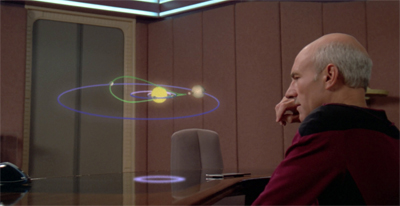
What goes around…
To be fair, the idea for the show was actually proposed to the producers by the guest star, during the Writers’ Guild of America Strike of 1988. According to The Next Generation Companion :
Howie Seago, who is actually deaf, met with the producers during the writers’ strike to suggest a show built around a deaf actor as a guest star. This episode is the result, and in it Seago helped to change what he felt was a dangerous myth regarding deaf people: the first draft’s premise had his character learning to speak overnight after the failure of a mechanical translator he used to communicate with his chorus. The day before shooting he suggested an alternative scenario, where after the killing of his chorus Riva stays on Solais V to teach the combatants sign language. To his surprise the idea was eagerly accepted; the supportive mail from both deaf and hearing people seemed to bear out the wisdom of that idea.
We can all agree that the ending Seago suggested is at least superior to the one proposed in the script. After all, there’s something quite sinister about the idea that you can “fix” a disability like that. Unfortunately, the scene between Geordi and Pulaski that remains in the finished episode contains the same connotations.

Be sure to let him know when you a-Riva at your destination…
It is possible for Star Trek to do great issue-driven storylines. For example, Symbiosis was one of the better episodes of the first season. Classic episodes like The Outcast and Rejoined would tackle homosexuality in clever ways. However, these episodes also have a tendency to take themselves too seriously, to rather clumsily manhandle the issue at hand, and to forget that a television series like this must first tell a story – and the way to explore these issues is through the story, rather than trying to awkwardly graft a story on to an issue.
Perhaps the most fascinating aspect of the episode is Riva’s chorus, which is killed off about half-way through in order to generate drama and suspense, forcing our character to start from scratch. The chorus is, on a purely visual level, a fascinating concept. However, it raises all manner of logical questions. It seems appropriate that this show focuses around Troi, as a lot of the issues raised by the chorus apply to her as well.

Is he just hoping hostilities will evaporate overnight?
We’re told that each of the three members of the chorus speaks to one side of Riva’s emotional spectrum. “We serve as translators,” one explains. “We convey not only his thoughts, but his emotional intent as well. I am the Scholar. I represent the intellect, and speak in matters of judgement, philosophy, logic. Also, I am the dreamer, the part that longs to see the beauty beyond the truth which is always the first duty of art.” Another observes, “I am passion, the libido. I am the anarchy of lust, the romantic and the lover. I am also the warrior, the perfect line which never wavers.” Finally, the third states, “I am that which binds all the others together. I am harmony, wisdom, balance.”
It seems a bit arbitrary that Riva’s emotional spectrum can be conveniently divided into three sections. It seems a bit reductive. I would imagine that emotions are somewhat broader and deeper than that. Still, Riva seems to place great emphasis on using these three voices to communicate with his audience. After they are killed, he dismisses Data’s ability to fill the void. “When Data speaks for me, can you hear my anguish, my despair?” he asks. “Data is a fine machine, but he cannot take the place of my chorus. It took years to develop a communication. That cannot be easily replaced.”

Yes, of chorus…
Here’s the thing, though. It seems a bit arbitrary that all the worlds in all the universe have the same emotional capacity as we do, and that emotions translate on a one-for-one basis across the galaxy. I know the chorus represent Riva’s emotional range, but he seems to emphasise how important that is to the people he addresses as well. It’s a bit of a problem I have always had with Troi – the idea that emotions can somehow be mapped on a one-for-one basis, particularly across cultures. It seems to reflect a human-centric view of the universe, with the idea that all species must rigidly adhere to our perception of the universe.
Of course, a later episode in the series, The Chase , would seem to explain why the Star Trek universe was populated with so many bipedal human-like aliens, and perhaps the same explanation accounts for how emotions tend to map the same across countless different species that evolved light-years apart. I can understand how that would make sense, but I’m still a little uncomfortable with the idea that there’s very few forces out there so alien that they don’t feel exactly the same way that we do.

Carrying the torch…
That said, if they didn’t, then we wouldn’t need Troi as the ship’s empath. Since Guinan seems to have quickly become the ship’s de facto counsellor (helping Wesley decide what he wants in The Child and helping Data investigate humour in The Outrageous Okona ), it would seem a bit harsh to take that away from Troi. She seems to have unfortunately little to do on the show at this point in its run, so I suppose we should be thankful that she can still state the blindingly obvious for the bridge crew.
This idea that everything must conform to humanity’s ideals and expectations is actually raised in the opening scene, and I’m a bit disappointed that the episode never really addressed it. Worf seems hesitant to welcome Riva on board. Picard explains, “Ah. Riva negotiated several treaties between the Klingons and the Federation.” Worf replies, “Before him, there was no Klingon word for peacemaker.”
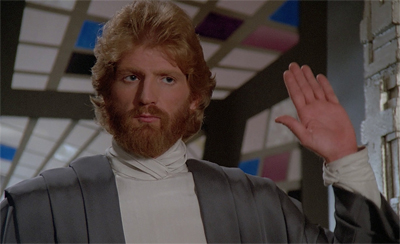
A Riva Derchi…
This seems to reflect what we saw in Heart of Glory , where human values couldn’t necessarily be applied to the Klingon Empire. We’re told that this cultural assimilation “bothers” Worf, and it’s great that nobody takes the opportunity to lecture him on the virtues of peace. The application of human ideal to the Klingon Empire was arguably one of the factors that contributed to its decay and corruption, proof that you can’t just apply human value systems across the board.
Unfortunately, this seems to be the one concession the episode makes, and we’re quite clearly back in “human superiority” mode. Picard hovers the Enterprise over Solias V and notes in his log, “We are monitoring increased military activity on Solais Five. I fear that without Riva, we will be unable to keep the Solari from destroying themselves.” It seems creepily paternalistic. It doesn’t have to be, but the script makes it seem like the inhabitants should be kissing the feet of the Enterprise crew.
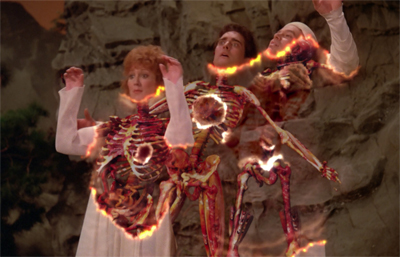
No bones about it…
Before I move away from the chorus as a concept, the script itself has some clunkiness. I feel a little uncomfortable about the fact that the script identifies the two male members of the chorus by their roles and archetypes, but has to label the woman as “woman.” How come the men aren’t similarly classified according to the script?
There are three of them… each a distinctive personality and physical archetype — the SCHOLAR/ARTIST, the WARRIOR/ADONIS, a CULTURED WOMAN.
I’ve written before that The Next Generation has some serious gender issues, and this seems like another example. Also, how come every Troi-centric episode so far (and quite a few to come) are based around the guest star of the week trying to get into her skin-tight jumpsuit? I mean none of the male cast are so consistently objectified in such a manner in their own stories.

“I knew it was you, Riva… and it broke my heart!”
Finally, apropos of nothing, I do find it a little hilariously awkward how Riva’s libido works, and how incredibly awkward and transparent it is. When he wanders off with Troi, he leaves “Scholar/Artist” and “Cultured Woman” behind, prompting them to rather awkwardly ask to be shown to their quarters. They seem to stop short of saying they’ll have a few hours off. “At times like this,” one states, “we become an encumbrance.” Man, I hate it when two out of three of my emotional chorus tend to ruin my dates.
There is also, unfortunately, the rather awkward way that Riva’s disability is portrayed as inherently alien. I know that the gender issues of The Outcast and Rejoined aren’t exact parallels for issues of modern sexuality, but Riva is deaf and dumb – and the episode stresses that these are pretty much the exact same disabilities that we see everyday. As such, treating Riva’s inability to hear or speak as something exotic and alien seems to undermine the point a bit.
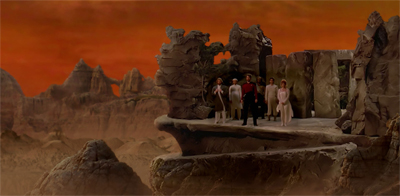
A civilisation at its peak…?
I’ve always felt that Geordi was the best way to handle that sort of issue in Star Trek . His blindness isn’t a secret – he isn’t treated as if he’s a character who can see, but with a funny comb on his face. Geordi is portrayed as different than the crew around him, and that difference stems from his inability to see. His blindness isn’t treated as something that makes him less capable than those around him, just something that means he perceives the world in a different way. The opening section of Heart of Glory might have seemed like clumsy padding, but it at least illustrated that Geordi comprehends the universe in a manner distinct from the rest of us.
So the episode is somewhat undermined by a scene between Pulaski and Geordi where she discusses “fixing” him using the magic technology of the replicators. Of course, the scene doesn’t use the word “fix” , but it uses words like “normal.” During a routine check-up, Pulaski reveals it is possible for Geordi to see again. “I can attempt to regenerate your optic nerve, and, with the help of the replicator, fashion normal eyes. You would see like everyone else.”

Seeing eye-to-eye…
This is where the show runs into problems. That’s a fairly massive decision to put in front of anybody. It’s a massive and important character subplot for Geordi as a character. However, it’s all clumsily crammed into one short scene. She asks Geordi, “Why are you hesitating?” He replies, “Well, when I came to see you, it was to talk about modifying this. And now you’re saying it could be possible for me to have normal vision?”
There’s no discussion of what “normal” means or what “like everyone else” is truly about. After all, much like the emotional spectrum above, it suggests that the human perception of the universe is an absolute rather than a subjective interpretation. At its worst, it seems to imply that Geordi has a problem that should be rectified so he can conform to human standards, that somehow seeing the universe as most humans do is the very pinnacle of perception.

A bit of a blind spot…
The scene was apparently written to provide actor LeVar Burton with the possibility of removing the VISOR and allowing the actor to emote with his eyes. I can understand the appeal of that proposal to a performer, but I also think that it would diminish the character in a very significant way. It was, at the time (and it still is), very rare to see people on television living with disabilities in a manner that doesn’t sensationalise or exploit. Geordi was blind, but that didn’t define him.
Geordi was a blind character whose characterisation didn’t really rely on that disability at all. It was just part of who he was, and it didn’t limit or restrict him in any way. He was surrounded by characters who respected and trusted him, and his inability to see didn’t reduce him in their eyes in any way shape or form – it didn’t limit his ability to contribute. I can’t help but feel like giving him “normal” eyes would send the wrong message to those watching and enjoying the series.

Real men fire pink lasers…
The scene was never touched on again, making it stand out even more than it does as part of the episode itself. You’d imagine that Geordi would have to digest and think about the proposal, and that it would weigh heavily on him. Instead, it is never mentioned ever again, which makes this feel like an especially surreal diversion. And positioning it in a story about another character coping with their disability makes it feel even more misjudged.
Finally, there’s Troi. It’s clear at this point in The Next Generation that the writers are trying to figure out what she is supposed to be doing. You’d imagine that the departure of the other two female leads might have inspired the producers and writers to do something dynamic or interesting in the character. Instead, we get this episode in which she is clumsily inserted into the story of a guest character, all so the episode can end with Picard bluntly telling the audience what a great character she is.

Going around in circles…
“You read me well enough to sense how I feel about you and what you do on this ship,” he states. “But I just wanted to say the words. Thank you. Well done.” It’s hardly the most subtle way of trying to convince the audience that Troi is a valued member of the crew, and it hardly seems earned. I mean, Wesley’s advice to Okona averted a potential war last episode, and he didn’t get a nice little speech – and he doesn’t even have the advantage of being able to read Picard’s thoughts. Ah well. How far way is Face of the Enemy ?
The Next Generation could do great issue-driven storytelling. Unfortunately, it could also bungle the concept completely. Unfortunately, As Loud as a Whisper feels more like the latter than the former.
Read our reviews of the second season of Star Trek: The Next Generation :
- Supplemental: Phase II (1978) – The Child
- Where Silence Has Lease
- Supplemental: Embrace the Wolf
- The Outrageous Okona
- Loud as a Whisper
- The Schizoid Man
- Supplemental: Deep Space Nine (Marvel Comics) #3-4 – The Cancer Within
- A Matter of Honour
- Supplemental: Myriad Universes – Echoes and Refractions: Brave New World by Chris Roberson
- Supplemental: The Measure of a Man (Extended Cut)
- Supplemental: Masks by John Vornholt
- Time Squared
- Supplemental: The Lost Era – Deny Thy Father by Jeff Mariotte
- Supplemental: (DC Comics) Annual #2 – Thin Ice
- Supplemental: Strange New Worlds VI – The Beginning by Anne Reed
- Supplemental: Star Trek: The Next Generation/Doctor Who – Assimilation²
- Supplemental: The Newspaper Strips – Beware the Omnimind! (aka Restructuring is Futile)
- Samaritan Snare
- Up the Long Ladder
- The Emissary
- Peak Performance
- Shades of Grey
Share this:
Filed under: The Next Generation | Tagged: Data , Federation , Heart of Glory , Howie Seago , jean-luc picard , Klingon , Outrageous Okona , Sign language , Star Trek Next Generation , star trek: the original series , StarTrek , Troi , William Riker , Worf |
3 Responses
Reblogged this on cienciayconcienciaccd .
I’m sorry but the entire concept of one of Riva’s chorus’ standing in as his talking libido just makes me think of Anastasia Steel’s ”inner goddess” or Harry Potter’s ”chest monster”.
Leave a comment Cancel reply
This site uses Akismet to reduce spam. Learn how your comment data is processed .
Recent Posts
- 373. Pirates of the Caribbean: The Curse of the Black Pearl (#225)
- 371. Poor Things (#246)
- 370. Dune: Part Two (#12)
- 369. Memento (#57)
- 368. Monty Python and the Holy Grail (#154)
Recently tweeted…
- "I Simply Am Not There": The Existential Horror of Eighties Excess in "American Psycho"...
- Star Trek: The Original Series (Reviews)
- The X-Files - Monday (Review)
- "The Things You Gotta Remember Are the Details": Reservoir Dogs and the Fragility of Memory and Meaning in the Nineties...
Available at…

Blogs Well Worth Your Time
- 1001 Must See Films
- Andrew at the Movies
- Anomalous Material
- Cut the Crap Movie Reviews
- Encore Entertainment
- Fandango Groovers
- FlixChatter
- Four of Them
- It Rains… You get Wet…
- Jameson Cult Film Blog
- Jar Watches Films
- Let's Go To The Movies
- M. Carter at the Movies
- Marshall and the Movies
- Movie News First
- Musings from a Man Lost in La Mancha
- Never Mind Pop Film
- Paragraph Film Reviews
- Roger Ebert's Journal
- Ross v. Ross
- Scannain.com
- Screenwriter (Donald Clarke, Irish Times)
- Strange Culture
- The Film Cynics
- The Pompous Film Snob
- The Projection Booth
- Things That Don't Suck
- Too Busy Thinking About My Comics
- Undy a Hundy
Film Nerd Resources
- CinemaBlend (News)
- Internet Movie Database
- Rope of Silicon
- The Guardian Film Blog
- James Berardinelli
- Roger Ebert
Email Subscription
Enter your email address to follow this blog and receive notifications of new posts by email.
Email Address:
Sign me up!
Blog at WordPress.com. WP Designer.
- Already have a WordPress.com account? Log in now.
- Subscribe Subscribed
- Copy shortlink
- Report this content
- View post in Reader
- Manage subscriptions
- Collapse this bar
- Show Spoilers
- Night Vision
- Sticky Header
- Highlight Links

Follow TV Tropes
http://tvtropes.org/pmwiki/pmwiki.php/Recap/StarTrekTheNextGenerationS2E5LoudAsAWhisper
Recap / Star Trek: The Next Generation S2E5 "Loud As a Whisper"
Edit locked.

Original air date: January 9, 1989
The Enterprise gets orders to transport a renowned mediator named Riva to Solais V to bring an end to a bitter war. Upon meeting him, the crew learns that he is deaf and speaks through three interpreters who communicate with him telepathically. Riva immediately finds himself taken with Counselor Troi and bonds with her over dinner.
Upon reaching Solais V, Riva beams down to settle the dispute with only Riker and Worf as security, reasoning that bringing anyone else will only increase tensions. But only moments after arriving (before they even have the table set up) one of the natives becomes angry and fires at Riva, somehow killing all three of his interpreters with one shot when Riker pulls him out of the way. After beaming out, Riva becomes despondent and loses faith in his ability to mediate a peace. Even after Data learns his sign language, he insists that he cannot be an effective mediator without his interpreters.
This episode provides examples of:
- 10-Minute Retirement : Riva's refusal to return to the negotiations lasts a few hours.
- Aborted Arc : One scene features Dr. Pulaski offering to grow new human eyes for Geordi, who leaves saying he'll think about it. This is never brought up again. The reason for this was to allow for the possibility of removing Geordi's need of the visor, which was due to a request from Levar Burton to be allowed to use his expressive eyes in the series. The plot point was dropped after the episode, however.
- Aliens Speaking English : Despite him being from another planet, Riva's sign language is seemingly identical to American Sign Language — which is understandable, as it's Howie Seago's native language, but doesn't make much sense in-universe. Since the Universal Translator doesn't really work as an explanation, * it might be designed to work on sign languages, but why translate a language the user doesn't understand into another one they don't understand? we can only guess that Translation Convention may be in effect.
- Armor-Piercing Question : When Troi asks Riva why he can't do what he does in his negotiations with himself - turn a disadvantage into an advantage.
- The royal house status goes by male line only ; haemophilia, being a recessive X chromosome gene, almost always goes only by female line (but only affects males), the exception being that a male haemophiliac who has children (which was rare until the mid 1900s) pass the gene to all his daughters and none of his sons. note The above explanation of the genetics of Haemophilia doesn't apply to type C, the rarest type. However, the family tree indicating who had Haemophilia does match the genetic information above. So haemophilia could not possibly go down a royal house.
- There actually were several haemophiliacs in European royalty. The source was a mutated gene in Queen Victoria , who was from the House of Hanover. It did not affect her; however, it did affect one of her sons (even he wasn't a Hanover), one of the sons of his daughter, and 7 grandsons and great grandsons of Queen Victoria through 2 of her daughters. None of them were from the House of Hanover.
- Although it can't be proven that the mutation was new with her, no members of her extended family, except her matrilinial descendants, had the disease.
- Queen Victoria wasn't even the first British monarch from the House of Hanover. She came after George I, George II, her grandfather George III , and her uncles George IV and William IV.
- Bilingual Bonus : Riva's signing is all genuine ASL. This unfortunately causes some issues during the scenes of Data's translating, as the differences in sentence structure mean he occasionally says a word before Riva makes the sign for it.
- Break the Haughty : Riva isn't a bad guy at all and likes the entire crew, but he was pretty overconfident in his abilities to defuse a war (especially considering the warring factions in question had been at it for fifteen centuries ). Either way, once his entire chorus gets wiped out right in front of him, his confidence and cool veneer is completely shattered.
- The Charmer : Riva turns on the ol' charm immediately upon seeing Troi.
- Despair Event Horizon : Riva is horrified after his chorus gets killed, pacing around the briefing room like a madman. Troi and Picard try desperately to calm him, but of course, that's not happening.
- Disability Superpower : Riva, who's deaf, is also telepathic. This is apparently a trait of his family, and possibly linked to their deafness (both are hereditary among them).
- Early-Installment Weirdness : The mention of Riva negotiating peace treaties between the Klingons and the Federation was an early attempt to explain how those former enemies became allies. Season 3's "Yesterday's Enterprise" later explained that the two sides became allies after the Enterprise -C heroically sacrificed itself defending Klingons at Narenda III, and Star Trek VI: The Undiscovered Country would show that peace was first established after the destruction of Praxis left the Klingon Empire unable to sustain their military might against the Federation.
- Fee Fi Faux Pas : When meeting Riva, Picard attempts to address the chorus instead of Riva, offending him. He later explains to Riker to treat the chorus as interpreters and thus address Riva directly.
- Forever War : The Solari factions has been fighting for fifteen centuries, leading both of them to the brink of extinction.
- Freudian Trio : Riva's psychic chorus literally represent parts of his mind. Superego Interpreter: I am the scholar. I represent the intellect, and speak in matters of judgement, philosophy, logic. Also, I am the dreamer, the part that longs to see beauty beyond the truth, which is the first duty of art. I am the poet who... Id Interpreter: Artists, they tend to ramble, neglect the moment. I am passion, the libido, I am the anarchy of lust, the romantic, and the lover. I am also the warrior, the perfect line which never wavers. Ego Interpreter: I am that which binds all the others together. I am harmony, wisdom, balance.
- Get a Hold of Yourself, Man! : Picard to Riva, by grabbing his head so Riva can read his lips and tell him he's not alone, after Riva's chorus is killed. With a bit of Translation by Volume with Picard shouting " LISTEN TO ME!! " to a deaf guy.
- Hive Mind : Consisting of only four people. Riva's chorus represent his Ego, Superego and Id , with each speaking Riva's thoughts that most closely correspond to those aspects of his mind. It can also be turned off and on at will—Riva brings only the Id voice to his dinner date with Troi, then dismisses him to communicate alone.
- It's All My Fault : Riva blames himself for his chorus' untimely deaths.
- It's Personal : Riva tells the Enterprise crew not to even bother investigating the reasons for the war provided in the background they've been given. It'll say that it's about some piece of land, or wealth, or something, but it doesn't matter. After fifteen centuries of fighting, nobody really cares about the original reason anymore. It's just personal now.
- Just Think of the Potential! : Worf is intrigued by the concept of sign language, observing that a form of communication which is both silent and covert could have other uses. (Of course, he's hardly the first person to have this thought.)
- Language Equals Thought : Before Riva negotiated several treaties with the Klingons, the Klingon language had no word for peacemaker.
- Mood Whiplash : The episode takes a deliberately slow pace in the first half to build up the mystique around Riva and his chorus. The result is that the tragedy that happens in the first negotiation attempt becomes that much more of a shock.
- Never Learned to Talk : Riva is deaf due to a congenital defect among the nobles of his planet. He has a group of interpreters who are telepathically linked to him, but otherwise can only communicate through sign language.
- "Ray of Hope" Ending : Riva isn't the same after his chorus is gone, but he does decide to give the peace negotiations one more try - by teaching the two factions sign language. The theory is, while they learn to speak to him, they'll learn to speak to each other. It's clearly going to be a process, but that's fine with Riva.
- Reading Lips : Riva certainly has no problem with this.
- Reconcile the Bitter Foes : After fifteen centuries of war, the Solari calls for Riva to lead the peace negotiations. The episode ends with Riva intending to teach both sides his sign language to communicate with him, and hopefully with each other.
- Renegade Splinter Faction : The representative that shoots at Riva to try and prevent peace is apparently from one of these. He is immediately shot dead as a traitor by the other representative of his supposed faction.
- Royals Who Actually Do Something : Riva is a member of the ruling family of Ramatis, and is also a renowned and experienced peace mediator.
- The Speechless : Riva's deafness is hereditary, and having grown up with his chorus, he doesn't speak. In the script it's said he doesn't even know how to read or write either, which is why he ignores Picard's suggestion that he write his thoughts down.
- Super-Speed Reading : Basically how Data learns all known sign language for Riva.
- Voice for the Voiceless : Riva's chorus telepathically conveys his thoughts. It's a hereditary position for them, corresponding to the equally hereditary condition of Riva's family.
- Wham Shot : When one of the tribesmen suddenly goes AWOL and shoots, instantly killing Riva's entire chorus.
- What Could Possibly Go Wrong? : Averted. Riker expressed some concern about allowing Picard to beam down to the planet to meet Riva. Picard points out that he's just going to greet a dignitary and there's no danger. It seems like the perfect set up for something to go horribly wrong. But other than a minor faux pas that was immediately forgiven, nothing went wrong at all.
- Star Trek: The Next Generation S2E4 "The Outrageous Okona"
- Recap/Star Trek: The Next Generation
- Star Trek: The Next Generation S2E6 "The Schizoid Man"
Important Links
- Action Adventure
- Commercials
- Crime & Punishment
- Professional Wrestling
- Speculative Fiction
- Sports Story
- Animation (Western)
- Music And Sound Effects
- Print Media
- Sequential Art
- Tabletop Games
- Applied Phlebotinum
- Characterization
- Characters As Device
- Narrative Devices
- British Telly
- The Contributors
- Creator Speak
- Derivative Works
- Laws And Formulas
- Show Business
- Split Personality
- Truth And Lies
- Truth In Television
- Fate And Prophecy
- Edit Reasons
- Isolated Pages
- Images List
- Recent Videos
- Crowner Activity
- Un-typed Pages
- Recent Page Type Changes
- Trope Entry
- Character Sheet
- Playing With
- Creating New Redirects
- Cross Wicking
- Tips for Editing
- Text Formatting Rules
- Handling Spoilers
- Administrivia
- Trope Repair Shop
- Image Pickin'
Advertisement:

Star Trek The Next Generation: Loud as a Whisper

Picard: There are aspects to Riva of which we have not been informed. Riva/Chorus: Precisely. Our way of communicating has developed over the centuries and it's one that I find quite harmonious. Picard: Then Riva the mediator... Riva/Chorus: Is deaf. Picard: Deaf? Riva/Chorus: Born, and hope to die.
9 comments:

I enjoyed rewatching this one. I liked the idea of the three different interpreters. I noticed that the handsome guy got to do the romantic interpretation for Riva. :) One detail I particularly liked was that the interpreters had white costumes but each was detailed and unique. Nice touch. I had a similar reaction when Riva was unable to communicate in some sort of written form, because any culture as advanced as his would have to have a reliable way to physically record knowledge, or they *wouldn't* advance. (Human advancement sped up after the printing press.) Riva immediately pursuing Troi also made me uncomfortable; it seemed out of character. And when Picard left Riva on the planet and he was just standing there waiting, I thought, um, does he have food, water, a place to sleep? Is there a nice hotel nearby in that stony outcropping in the middle of nowhere? :) Excellent review, Joseph. What a fun read.

I enjoyed the episode more than most recently. It was an interesting concept and I agree props to someone who is deaf saving the world. The scene I found uncomfortable was Picard yelling at Riva, which is a somewhat common, ignorant response to people who are deaf. I would have hoped that he, future type Renaissance man that he is, would know better. Thanks for the fun review Joseph and I'm sure there's a Bedrock hotel just around the corner Billie.
Billie - I love writing for this site! People lead me to new points even unintentionally. In the "real" world, ASL interpreters almost always wear black or dark colors. I think you caught that the producers were playing with that fact! Drnananmom - yep - I felt Picard was really thrown by someone being Deaf for some reason. Often, people who put a lot of their personal "power" into speaking verbally tend to have that reaction. JRS

Often, people who put a lot of their personal "power" into speaking verbally tend to have that reaction. I've never seen this episode, or even any episode, but now I'm tantalized by what my own personal, interactive-with-others power might be (in the way that you mean, which I've never thought about before). Hmm...
Nice review -- I haven't seen that episode for a LONG time -- maybe not since it first aired. I'd have liked to see some more discussion/analysis of the crew's "pushiness" -- Seems to me it's a fairly common thing for Hearing people -- Deaf people's feelings are typically disregarded, but since they NEED this particular Deaf person for something, they try to force him into some mold or force him to communicate their way or something -- I haven't quite articulated what I mean or am thinking on this, but it does strke me somehow. As for Data's signing/interpretation, well.... Mandela Interpreter, anybody?
Data was good just got ahead of Riva's signing. He was saying words Riva hadn't signed yet, but we can put that up to android.

Great review! I really want to watch this episode again. I thought the corpus that Data used to speed-learn sign language was interesting. It only showed handshapes, no dynamic pictures/references or facial expressions. At the same time, they references varying sign language, recognizing that there isn't just one intergalactic sign system.
I love watching this episode coz I am trying to learn ASL and when I was trying to see the signs when data was looking up signs and could not keep up but was glad they made a episode for the deaf.

It's difficult for those of us who aren't deaf or blind, or have other such challenges to know what those who do have to deal with. That being said, I did enjoy this one, and found Riva to be a very engaging and sympathetic character. They run roughshod over his grief which I find hard to reconcile with how the crew should have actually reacted to it. Losing people close to you, and who aid you with your important diplomatic work like that would be extremely traumatic. Troi was great here, and I do wish they would have avoided the rather cringe-worthy way Riva initially interacted with her, it is definitely on the creepy side. Barring that, I felt not only was the best option for such a communication, but that she was great as how she handled it too.
We love comments! We moderate because of spam and trolls, but don't let that stop you! It’s never too late to comment on an old show, but please don’t spoil future episodes for newbies.

- LOW Season 1
- LOW Season 2
- LOW Season 3
- TNG Season 1
- TNG Season 2
- TNG Season 3
Learn Stuff
- Gauntlet Combos
- NOT MyCrew™
- Upload from Game
- About MyCrew™
- Special Crew
- Current Event Crew
- Collections
- NOT in Collections
- NOT in Portal
- Captain Avatars
- Captain kellyplanet.com
- Head 2 Head
- Single Crew Traits
- ALL Actors, Species, Traits, etc.
- How It Works

Riva Riva Ramatis III Native Howie Seago The Next Generation Super Rare Crew Ramatis III Native Diplomat Linguist Telepath Cultural Figure Royalty Diplomacy Skill Science Skill Evasion New Life and New Civilizations Cultural Impact
Share this:
- Click to share on Facebook (Opens in new window)
- Click to share on Twitter (Opens in new window)
- Click to share on Pinterest (Opens in new window)
- Click to share on Reddit (Opens in new window)
- Click to share on WhatsApp (Opens in new window)
Leave a Reply Cancel reply
You must be logged in to post a comment.
Similar Crew
The Next Generation SINS OF THE FATHER 3x17
By erickelly 7 hours ago
The Next Generation THE OFFSPRING 3x16
By erickelly 3 days ago
The Next Generation YESTERDAY`S ENTERPRISE 3x15
By erickelly 5 days ago
kellyplanet STT Updates 24.04.10
By erickelly 6 days ago
STT Skirmish Event THE DARKEST TIMELINE & New Crew
GAUNTLET CREW Skill Combos
VOYAGE RATING Top 10 Hot Lists

KELLYPLANET
- ABOUT erickelly/kellyplanet
- Privacy Policy
kellyplanet
Shop.kellyplanet.com, star trek timelines, themugbar.com.


Contact erickelly

Memory Beta, non-canon Star Trek Wiki
A friendly reminder regarding spoilers ! At present the expanded Trek universe is in a period of major upheaval with the continuations of Discovery and Prodigy , the advent of new eras in gaming with the Star Trek Adventures RPG , Star Trek: Infinite and Star Trek Online , as well as other post-57th Anniversary publications such as the ongoing IDW Star Trek comic and spin-off Star Trek: Defiant . Therefore, please be courteous to other users who may not be aware of current developments by using the {{ spoiler }}, {{ spoilers }} OR {{ majorspoiler }} tags when adding new information from sources less than six months old (even if it is minor info). Also, please do not include details in the summary bar when editing pages and do not anticipate making additions relating to sources not yet in release. THANK YOU
- Memory Beta articles sourced from video games
- Memory Beta articles sourced from games
- Federation ambassadors
- View history
- 1 Biography
- 2.1 Appearances and references
- 2.2 External link
Biography [ ]
In 2359 , he and Sarek helped to broker a temporary peace between Cardassia and the Federation . ( TLE novel : The Buried Age )
He used a telepathic 'chorus' to talk to people. ( TLE novel : The Art of the Impossible ; TNG episode : " Loud as a Whisper ")
Appendices [ ]
Appearances and references [ ].
- TLE novel : The Art of the Impossible
- TNG episode : " Loud as a Whisper "
- ST video game : Infinite (picture only)
External link [ ]
- Riva article at Memory Alpha , the wiki for canon Star Trek .
- Riva article at the Star Trek Timelines Wiki .
- The Inventory
Star Trek: Discovery Would Really Like You to Know What It's About
Discovery 's final quest continues in "jinaal," giving it an opportunity to yell loudly what the show has always been about, for those in the back.
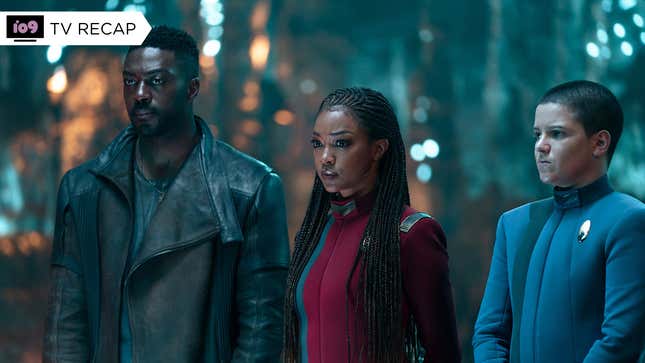
Star Trek: Discovery has always been about one thing: at the end of it all, the only thing that matters, the only thing that will bring light in dark times, and save the day, is a connection and understanding forged between people, regardless of who they are or what they’ve done. Sometimes, it’s more subtle about reminding us of this than others. This week was definitely one of the others.
Related Content

“Jinaal” is quick to get going after last week’s explosive two-episode premiere gave Michael and the crew a TNG -throwback mission to stop the mysterious Moll and L’ok getting their hands on Progenitor tech—and use their leg up on the duo wisely to get on to the Trill homeworld as soon as they can, in the search of the next clue to the Progenitor puzzle. It turns out, they’re actually looking for a person, so much as they are the clue—the titular Jinaal, a host of the Bix symbiont, who worked with the Romulan science team that discovered the technology’s existence eight centuries prior, at the height of the Dominion War .
Bad news: Trill don’t live for 800 years, and Jinaal is very, very dead. Good news: symbionts are much more lasting, and it turns out the Bix symbiont is still around with its host, Kalzara. Better(?) news: after answering a very simple riddle, Kalzara agrees to undergo a Trill ritual known as the Zhian’tara—a process seen in DS9 and Discovery that allows the consciousness of a past joined Trill to be put in another body for a period of time. After Dr. Culber eagerly accepts to be Jinaal’s organic AirBnB, the transfer is done, and Michael and Book are off on Culber-Jinaal’s tail to go find the clue.
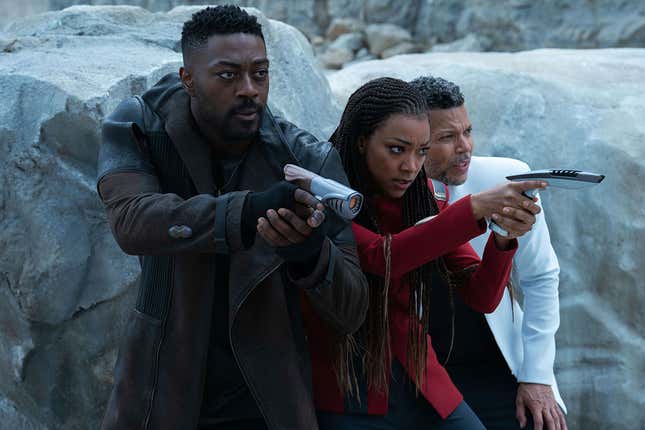
If all this sounds like it’s going at an alarming pace, it is and it isn’t. While “Jinaal” certainly gets going very quickly, there is both not much else to the episode and also a big breath and pause, because Discovery gets ready to lay its forever thesis on thick . All of this—all of it, not just the main thrust of the episode but its parallel stories aboard the Discovery with new first officer Commander Rayner, and back at Federation HQ with now-Ambassador Saru—is in service of people facing something, momentarily struggling, and then realizing “oh, this is much more solvable when everyone talks to each other and connects. Hooray!” And like we said, not only does the episode slow itself down to make this point clear, it makes this point plainly and repeatedly for the rest of the episode.
Look, this is not necessarily a bad thing—it’s actually been for the most part very beneficial for Discovery for it to embrace that this idea, an intrinsic aspect of Star Trek ’s hope for the future, is the core of its identity. Star Trek ’s ideal is people from across different species, backgrounds, gender identities, linguistic barriers, adversarial pasts, even across lines of understanding of radically different forms of sentient life, coming together in the face of evil and standing against it as one. Coalescing itself around that idea has given Discovery both a certainty and a confidence in recent seasons that at its most frustrating points, it deeply lacked. But god, sometimes you just gotta chill on it having every character in every storyline of an episode saying that idea to each other back and forth.
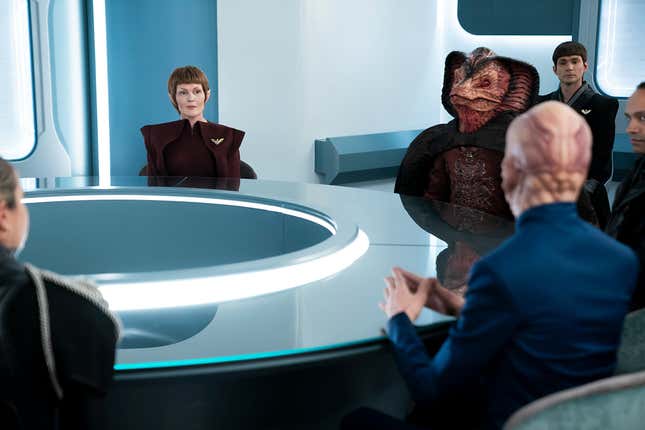
We see it on Trill, when it turns out Jinaal is leading Michael and Book into a nest of invisible, barb-shooting giant creatures—a test to see if, when faced with unintentional aggression, they reply in turn or seek to find a peaceful solution so every party gets what they want (hazard a wild guess which one Michael does, and therefore proves herself worthy of inheriting the next clue to the Progenitor tech). We see it back on Discovery , when the irascible Rayner, ordered by Michael to do one-on-one social introductions with the senior crew, treats everyone so brusquely that even Tilly has to snap at him and tell him to stop being a jerk trying to prove himself and actually get to know the people he’s now working with (Rayner’s “this meeting will last with you saying 20 words about yourself, max” attitude does at least let us give some of Discovery ’s awkwardly barely known crewmembers pockets of personality though, that’s nice). And we even see it back at Federation HQ, when Saru’s first day as an ambassador sees him forced to reckon with the political worries of whether or not his engagement to T’Rina will upset her career, after he learns of potential pushback to her husband-to-be from Vulcan purists.
In the end, all of these storylines end the same way: our heroes embrace understanding and seeking connection over aggression and division, and realize their problems are best solved when everyone talks to each other. Michael and Book get the clue (although we learn at the every end of the episode that Trill’s famously tight security of guys in red robes going “I dunno man, I’m just here to ask you a riddle” is in fact not so tight, after Mol sneaks in Guardian disguise to plant some kind of tracking device on Adira), having convinced the creatures and Jinaal alike that their intentions are peaceful. Rayner eventually realizes, after a drink and Tilly’s further prodding, that the only way he’ll get the respect of the Discovery crew that he had with his former one on the Antares will come when he offers himself openly in respect to them. And of course, Saru and T’Rina’s brief disagreement over their protectiveness of each other is quickly resolved when they actually talk to each other and make their feelings clear, instead of making assumptions and debating over it internally.
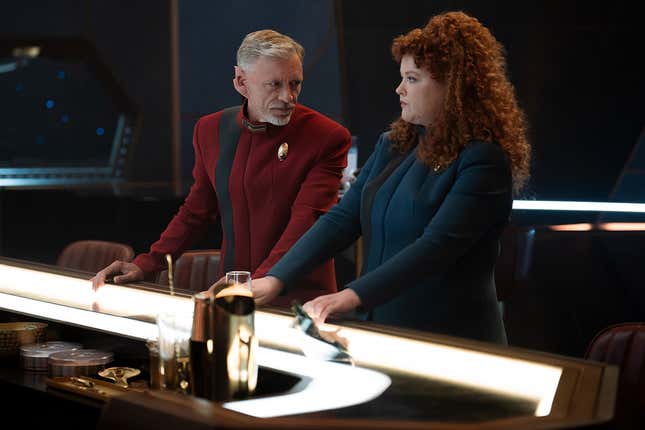
“Jinaal” then is not a bad episode. It’s breezy, it’s got some fun moments, Wilson Cruz gets to loosen up a little playing host to Jinaal’s consciousness for a while, and while the action here isn’t quite as on the scale of the premiere’s shootouts and chases, it’s still really fun (one of the best things about Discovery ’s jump to the 32nd century has been about how it plays with near-instantaneous, localized beaming, and it’s used greatly here). It just happens to be a distinctly unsubtle one in ways the show has only rarely dipped into being in the past. Nothing particularly advances here beyond the team getting the next bit of the Progenitor puzzle and moving on, there’s no real character work beyond little kernels setting things up to come, nor are Discovery ’s oft-hammered-home themes particularly challenged here: they are just repeated, very, very clearly, across multiple fronts.
Hopefully now that it’s sure everyone’s paying attention, it can hammer home those themes a little more gracefully as the adventure continues.
Want more io9 news? Check out when to expect the latest Marvel , Star Wars , and Star Trek releases, what’s next for the DC Universe on film and TV , and everything you need to know about the future of Doctor Who .
Advertisement
Star Trek Just Doubled Down on Its Wildest Body-Switching Concept
Welcome back to Trill.
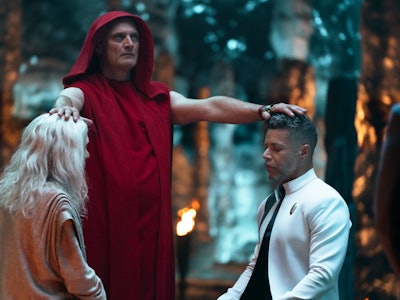
Body switching is a classic sci-fi trope. From Freaky Friday to Farscape , and of course, most of Quantum Leap, the idea of the consciousness from one person inhabiting the body of a different person will never stop being the fuel for speculative stories that are both hilarious and profound. But, when Star Trek invented the “joined” species of the Trill in 1991, it took the body-switching/body-surfing trope to a new level. While a specific Trill symbiont might live for several hundreds of years, this slug-like creature generally inhabited a humanoid host. This “joining” often created a new hybrid personality each time, sort of like Time Lord regeneration from Doctor Who mashed up with internal alien parasites from Alien; a chest-burster that never burst, but just stayed in you forever.
And if all of that wasn’t wild enough, on June 12, in the episode “Facets,” 1995, Star Trek: Deep Space Nine added a new wrinkle to Trill canon. Not only were the memories of all the previous hosts alive and well in the current symbiont, but, through a process called “zhian’tara,” a specific host’s personality could leave the symbiont and enter into the body of... anyone! Basically, this was Trill joining via spacey magic, and now, 29 years after “Facets,” Star Trek: Discovery is doubling down (tripling down?) on this very specific form of consciousness transfer in the Season 5 episode “Jinaal.” Spoilers ahead.
The Trill host trick
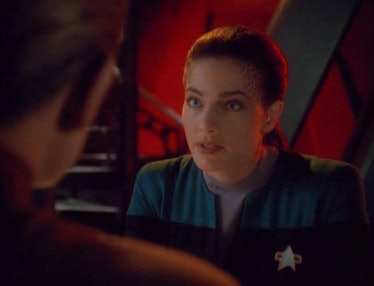
Dax and Odo discuss sharing memories in “Facets.”
Although the Trill were established in The Next Generation episode “The Host,” the vast majority of Trill canon comes from Deep Space Nine , thanks to the presence of Jadzia Dax, who later, in Season 7, switched hosts and became Ezri Dax. But, in the memorable Season 3 episode “Facets,” Jadzia’s previous host, Curzon, left her body through the zhian’tara process and settled in the body of the station’s resident shapeshifter, Odo. From that point, Odo’s entire personality was merged with Curzon’s, which put everyone on the station in a deeply uncomfortable position.
As a stand-alone episode of DS9 , “Facets” remains a fantastic story about memory, regret, and what one generation owes the next. But, the legacy of “Facets” is easily the concept of zhian’tara, which was used to save Gray Tal’s consciousness in Discovery Season 4, and now, in Season 5, is being employed again to unravel an 800-year-old mystery.
Discovery’s return to Trill
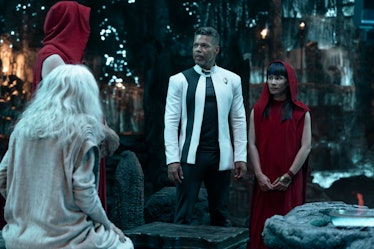
Cubler (Wilson Cruz) takes on an ancient Trill tradition in Discovery Season 5.
The planet Trill was first seen in DS9 in the episode “Equilibrium,” but Discovery has actually visited the planet more times, starting in the Season 3 episode “Forget Me Not,” and now again, in “Jinaal.” This time the need to transfer the memories of one previous Trill host into someone else is all connected to the secrets Jinaal Bix has about researcher of the Progenitors in the 24th century.
After transferring Jinaal’s consciousness into Culber, the entire personality of our stalwart Starfleet doctor changes, and, just like “Facets,” he suddenly becomes cockier, and more evasive. If you watch “Facets” right after watching “Jinaal,” the parallels are clear. While Curzon’s secret was connected to something personal, Jinaal’s secret has broader implications. Turns out, Federation scientists were working on cracking the Progenitor tech during the era of the Dominion War, and so they decided to bury any knowledge of the technology to prevent any planet or government from weaponizing their research.
Interestingly, this detail dovetails with Picard Season 3 a bit, in which we learned that Section 31 was pushing different Federation scientists to weaponize the organic nature of Changelings. Basically, the Dominion War created a lot of corrupt scientific research within the Federation, making the top-secret Daystrom labs that Riker, Raffi, and Worf raided perhaps just a small sample of the horrible top-secret weapons the Federation has developed.
What Discovery does is make it clear that Jinaal did the right thing at the time by hiding the research — even if that doesn’t help our heroes at the moment.
A classic Original Series nod
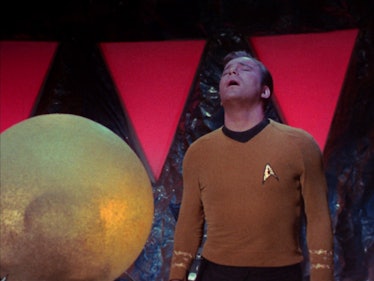
Sargon enters Kirk’s body in “Return to Tomorrow.”
Of course, within the canon of Trek, the Trill weren’t the first time the franchise explored the concept of sharing consciousness. Spock transferred his katra to Bones in The Wrath of Khan , and Kirk switched bodies with Janice Lester in the controversial final TOS episode “Turnabout Intruder.”
But, one wonderful 1968 episode from TOS Season 2 — “Return to Tomorrow” — featured ancient beings borrowing the bodies of Kirk, Spock, and Dr. Ann Mulhall in order to build more permanent, android bodies. When the ancient being of Sargon enters Kirk’s body, one of the first things he says is: “Your captain has an excellent body.”
Now, 56 years later, when Jinaal finds himself in Culber’s body, he says something similar: “Wow, this guy really works out!”
Across decades of internal canon, Star Trek can make the same body-switching joke, and make it work, in any century.
Star Trek: Discovery Season 5 drops new episodes on Fridays on Paramount+.
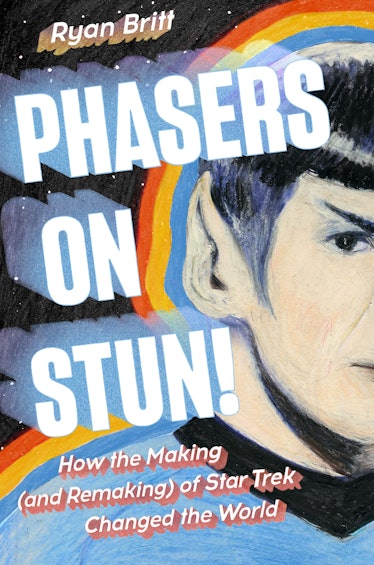
- Science Fiction
Screen Rant
Wilson cruz killed it playing star trek: discovery's trill.
Wilson Cruz got to play a different character in Star Trek: Discovery season 5, and he absolutely nailed the performance as an 800-year-old Trill.
Warning: SPOILERS for Star Trek: Discovery Season 5, Episode 3 - "Jinaal"
- Wilson Cruz shines as Dr. Culber possessed by Trill host Jinaal in Star Trek: Discovery Season 5, Episode 3.
- Burnham and crew hunt for the Progenitors' treasure in an intergalactic adventure, following clues in the latest episode.
- Cruz based his performance as Jinaal on Jack Palance in City Slickers.
Wilson Cruz's Dr. Hugh Culber gets temporarily possessed by an 800-year-old Trill in Star Trek: Discovery season 5, episode 3, "Jinaal", and Cruz absolutely kills it with his performance. In its fifth and final season, Discovery sends Captain Michael Burnham (Sonequa Martin-Green) and the crew of the USS Discovery on an intergalactic treasure hunt to find the ancient and powerful treasure of the Progenitors. In a story that began in Star Trek: The Next Generation's "The Chase," Burnham and her crew must follow a series of clues that lead to the technology the mysterious Progenitors used to create all humanoid life.
In Star Trek: Discovery season 5, episode 3 , "Jinaal," written by Kyle Jarrow and Lauren Wilkinson and directed by Andi Armaganian, the USS Discovery travels to Trill to find an 800-year-old symbiote whose original host helped hide the Progenitors' technology. In a variation of the Trill ceremony known as zhian'tara (first introduced in Star Trek: Deep Space Nine) , Dr. Hugh Culber allows his body to be inhabited by the consciousness of a Trill host named Jinaal. Written by Kyle Jarrow and Lauren Wilkinson and directed by Andi Armaganian, the third episode of Discovery season 5 reveals more information about the Progentiors' treasure and the six scientists sent to find it.
Star Trek: Discovery Season 5 Returning Cast & New Character Guide
Wilson cruz was great as dr. culber posseed by a trill in star trek: discovery, cruz makes jinaal truly feel like an entirely new character..
In the Star Trek aftershow, The Ready Room , hosted by Wil Wheaton, Wilson Cruz said he was "extremely excited" when he learned he would get to play a character other than Dr. Culber. Cruz revealed a little bit about how he imagined the character of Jinaal, saying:
Now that everybody's seen it, I will let you know that in my head, I had like a Jack Palance in City Slickers. You know, this person who was clearly there, having a great time being in the world again, but also knew that he had a mission.
Cruz went on to say that he wanted to make sure Jinaal was "distinct from Culber," and the actor certainly accomplished this. Because Dr. Culber has been struggling with his traumatic experiences, it was great to see Wilson Cruz express real joy as Jinaal. In only a few scenes, Cruz made Jamaal feel like a completely realized character, who was entirely separate from Hugh. From the way he talked and moved to the way he interacted with the world around him, Jinaal felt like someone who was savoring every second he had in this temporary body. From the moment Jinaal opened Culber's eyes, it was clear he was his own character with a big personality.
Star Trek Characters Inhabited By Aliens Is A Star Trek Tradition
It seems like every main star trek character gets possessed at some point..
Dr. Culber is far from the only Star Trek character to be inhabited by another consciousness , as the practice has become something of a Star Trek tradition. From Star Trek: The Original Series through the modern day, nearly every Star Trek show has featured one of the main cast members being possessed or inhabited by an alien presence. The word possession has a negative connotation, and this holds true for many of the possessions in Star Trek, while others are merely alien beings seeking to learn. Star Trek: Deep Space Nine, for example, had Trill transfers using the same zhian'tara ceremony used on Dr. Culber, and the villainous Pah-wraiths, whose possessions were much more destructive.
In the most devastating Star Trek possession, a Pah-wraith-possessed Dukat (Marc Alaimo) killed Lt. Commander Jadzia Dax (Terry Ferrell) just after she had decided to have children with her husband, Lt. Commander Worf (Michael Dorn).
Storylines involving alien possession also allow actors to play different characters, which, with Star Trek's talented crop of actors, is always fun to see. On Star Trek: The Next Generation , Brent Spiner got to play numerous characters, as Lt. Commander Data seemed to get possessed or otherwise inhabited more often than most. From dead ancestors to parasites to ancient gods and every kind of non-corporeal alien in between, Star Trek has dipped into the possession well many times, for both good and ill. Thankfully, Jinaal causes no harm to Culber, although the experience does seem to have a profound effect on Star Trek: Discovery's doctor, the full repercussions of which remain to be seen.
New episodes of Star Trek: Discovery stream Thursdays on Paramount+.
"Star Trek: Discovery" makes a case for Michael Burnham as the last great Starfleet captain
Our "discovery" protagonist was never going to have it easy. the start of her last run solidifies her greatness, by melanie mcfarland.
Michael Burnham's " Star Trek " journey was destined to be among the franchise's toughest and most complex. Some of us knew this from the moment Sonequa Martin-Green was cast to play her, especially Black women who are sci-fi geeks. We have never been few, but until recently, we were far less visible than we are now.
To some, this visibility symbolizes everything that has supposedly gone wrong with this franchise and others. The reach of " Star Trek: Discovery " goes even further by assembling a truly inclusive cast that blew apart the original series' longstanding heteronormativity.
All this further angered culture war trolls and self-appointed arbiters of what is so-called "real" "Star Trek." These people have a vested interest in downvoting any such divergences from what has gone before.
Mainly it was — as it continues to be — the purists who wrote off "Discovery" as "not Trek" during its first season in 2017 . Looking back from its final season — and from the perspective of Burnham's 900-year journey — we can say that despite how its thematic shading looked to us then , "Discovery" never abandoned Gene Roddenberry's optimism . It has simply evolved its interpretation.
In the first season, not even Burnham would believe this to hold true. A human raised on Vulcan by Spock's father, Sarek, and as his sister, Burnham earns her first officer role through superior conduct and logic, divorcing herself from sentiment.
Burnham's smug sense of rectitude gets her superior officer killed. She is charged with mutiny, stripped of her rank and sentenced to life in prison.
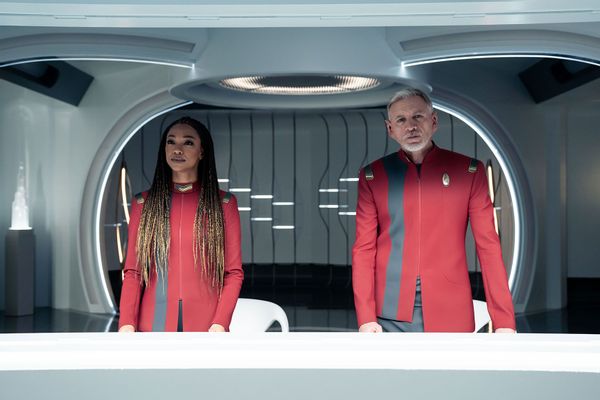
From there, she stops a rogue galactic A.I. from annihilating the Federation and leaps nine centuries into the future (thereby largely freeing herself and the show from restrictive canon) to find a universe where Starfleet as it used to be is a dream, and the Federation and its ideals are broken.
"Discovery's" swansong season finds Burnham in the year 3191, with enough of the Federation's trust to take on a highly classified mission alongside Captain Rayner (Callum Keith Rennie), who has already earned the same commendations as Kirk and Picard. His reputation precedes him, in other words. Their quest relates to a Picard-era discovery that Starfleet fears can be used to eradicate all humanoid life in the universe.
"Discovery" never abandoned Gene Roddenberry's optimism. It has simply evolved its interpretation.
Their success should place her on par with the greats, an honor that showrunner Michelle Paradise and the show's co-creator Alex Kurtzman have been driving toward all this time.
Some indicators of that goal aren't as obvious as others, like the sequence in which Rayner defies Burnham during an away mission, trusting in his overconfidence instead of her strategic acumen. His snap judgment endangers a planet's civilian population, leaving her to fix the crisis he has created.
Women watching this — especially Black women, I would wager — might have experienced a slight rage triggering in their soul that was mollified by Burnham pulling the very Obama-esque move of asking Rayner to replace her trusted friend Saru (Doug Jones) as her first officer. (The job was coming open, anyway; Saru is shifting into diplomacy mode and getting married.)
This is the move of a great leader. Then again, like Kate Mulgrew's long underappreciated Captain Janeway, it may not be appreciated by the fandom for many, many years.
Burnham's arc contradicts what we know about the great Starfleet captains profiled in this franchise, most of whom are white and male.
Burnham's arc contradicts what we know about the great Starfleet captains profiled in this franchise, most of whom are white and male, though if that were the extent of what differentiates her from the rest, it would barely be worth mentioning.
Records of their histories come to us as snippets of dialogue from secondary characters or contextualizing conversations from what the official logs have to say about past missions. We hear about who served under whom, granting legitimacy to the likes of, say, Christopher Pike to claim the captain's chair long before Anson Mount made us ecstatic to see that happen.
Burnham's path to the helm's command begins with what should be a life- and career-ending mistake. It's constantly defined by humility and doubt. No one is harder on Burnham than she is on herself — and nobody takes as many risks with their career or reputation to keep their crew alive. Her optimism is one guided by the hope that all obstacles can be overcome and all outcomes are possible, including for herself.
Despite all of this, it will take a lot of convincing for some people to consider Burnham among the top ranks of Starfleet captains in those occasional fan polls that tend to place Jean-Luc Picard or James T. Kirk in the top positions, though Captain Pike has offered stiff competition since "Strange New Worlds" first aired.
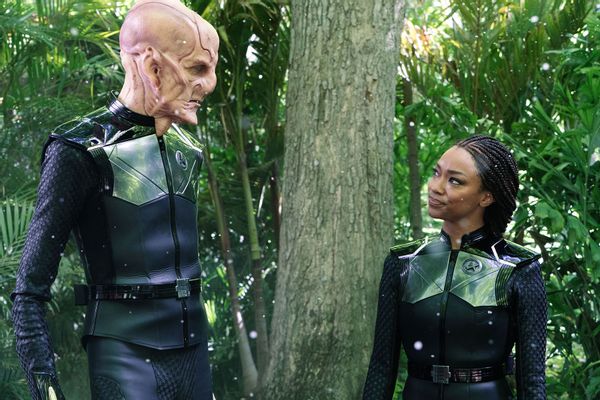
But our relatively newfound love of Pike and that show wouldn't be possible without "Discovery" venturing into the unmapped asteroid field that is the public's willingness to boldly go back to a dormant franchise in a wildly disunified era.
This doesn't merely refer to the role of "Discovery" introducing Mount's Pike, in addition to launching every other new "Trek" spinoff along with the streaming service currently known as Paramount+ . It did all this along with shouldering the more precarious mission of serving as the franchise's vanguard in a cynical age.
If you love "Lower Decks" and "Strange New Worlds," this is in part due to the producers' listening to the fandom's programming desires accordingly. Notice, for example, how unlike the first season of "Picard" is from the third . Initially, "Picard" tried to do something different with the beloved character. It ended his adventures by reassembling the band for the spectacular last ride their films denied them. The new "Star Trek" series have a goal of delivering something for everyone, including kids. "Discovery" helped its custodians figure that out.
We need your help to stay independent
And if you love "Discovery," its devotion to showcasing those who long felt unseen in this franchise may kindle that affection. "Discovery" gave us an Asian woman as a Starship captain in Michelle Yeoh's Philippa Georgiou and a happily married duo to root for in Wilson Cruz's Dr. Hugh Culber in Anthony Rapp's Paul Stamets.
It introduced Tig Notaro in its second season as Jett Reno, a decision for which everyone should be grateful. The third gave us the franchise's first transgender and non-binary characters in Ian Alexander's Trill Gray and Blu del Barrio's Adira Tal.
Through it all, we have also entirely fallen for Mary Wiseman's Sylvia Tilly, a woman who also knew a few things about self-doubt and, therefore, values being understood.
What some would cite as humanizing traits, others might write off as maudlin, along with the fact that Burnham was able to experience a fully realized love affair that began with a partnership of equals with a courier named Booker (David Ajala).
Want a daily wrap-up of all the news and commentary Salon has to offer? Subscribe to our morning newsletter , Crash Course.
It's only one of the many ways that "Discovery" is consciously disparate from "Star Trek" as we have long known it, daring to change everything from the look of the Klingons to its star character's role in igniting a war between them and the United Federation of Planets.
That was then. Hundreds of years after that moment, Captain Burnham has figured herself out, proving to the many who doubted her that she deserves to be there.
She has traveled the longest road through imposter syndrome of any Starfleet captain — most of a millennium, actually — and we have witnessed every major moment that forged her. Burnham may never win the major "Star Trek" popularity contests for favorite captains, but without a doubt, she's the last great one we may ride with in this universe.
New episodes of "Star Trek: Discovery" stream Thursdays on Paramount +.
stories about "Star Trek"
- "Star Trek: Strange New Worlds" considers the weight of Khan's wrathful legacy
- How "Strange New Worlds" uses Rebecca Romijn's Number One to place prejudice on trial
- "Pike made jambalaya": How "Strange New Worlds" Captain Pike expresses care and diplomacy with food
Melanie McFarland is Salon's award-winning senior culture critic. Follow her on Twitter: @McTelevision
Related Topics ------------------------------------------
Related articles.
- More to Explore
- Series & Movies
Published Apr 5, 2024
RECAP | Star Trek: Discovery 501 - 'Red Directive'
There's never a dull moment for the U.S.S. Discovery!
SPOILER WARNING: This article contains story details and plot points for Star Trek: Discovery.
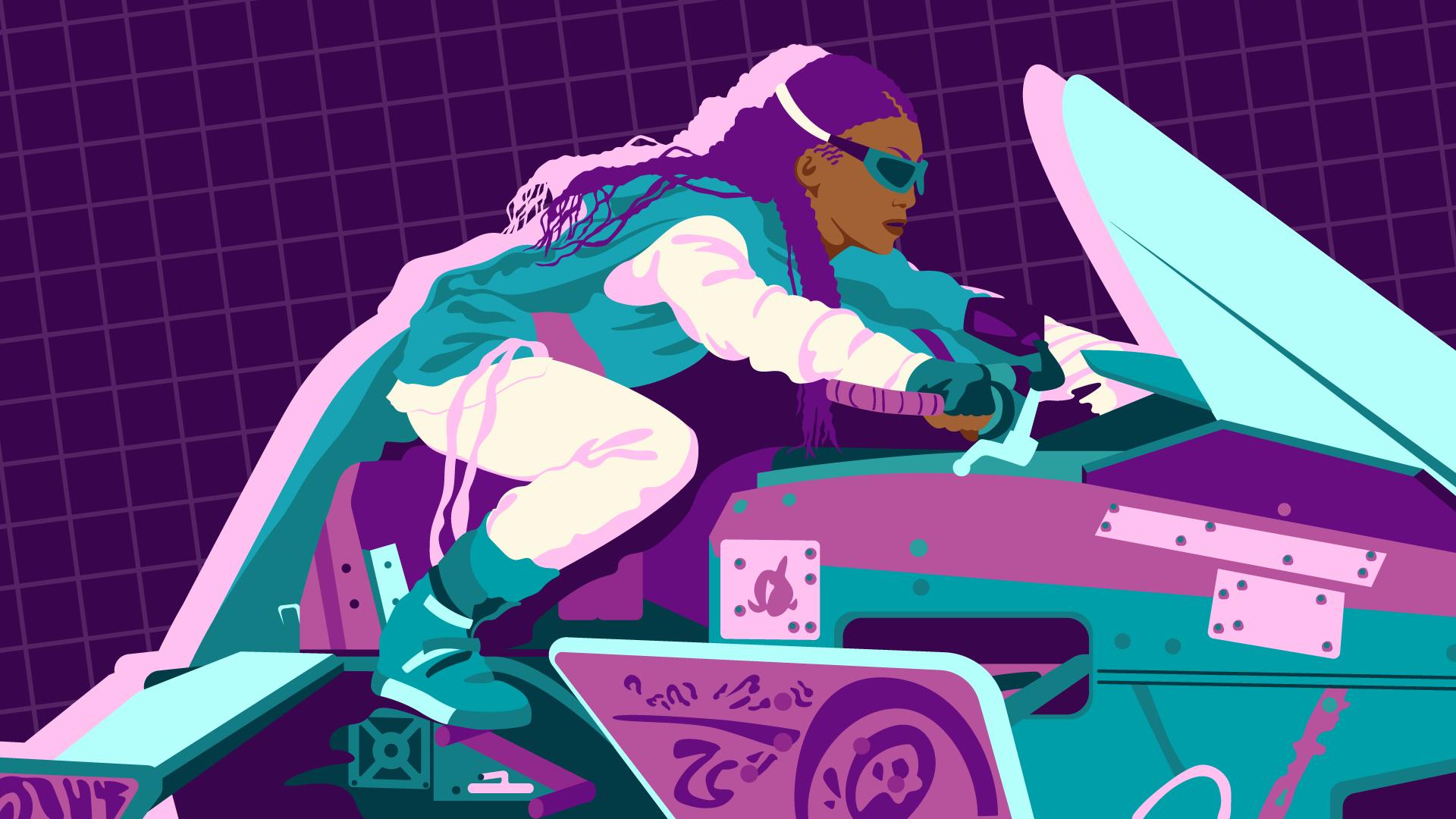
StarTrek.com
The fifth and final season of Star Trek: Discovery opens with " Red Directive, " where Captain Burnham and the crew of the U.S.S. Discovery are sent to retrieve a mysterious artifact hidden inside a 800-year-old Romulan vessel – but find that they’re not the only ones on the hunt. Meanwhile, Saru is offered the position of a lifetime.

- Michael Burnham
- Hugh Culber
- Paul Stamets
- Sylvia Tilly
- Laira Rillak
- Charles Vance
- Christopher
- Joann Owosekun
- Keyla Detmer
- Cleveland "Book" Booker

- Federation Headquarters
- U.S.S. Discovery -A
- U.S.S. Antares

As a vessel traverses the stars at high warp, Captain Michael Burnham experiences exhilaration as she clings to its hull in her environmental suit. The captain quips that there’s "never a dull moment" and proceeds to use her phaser in a bid to knock out the starship's engines. Burnham notes that they need to retrieve an item taken from a vault over the comm channel. As her suit advises her that warp bubble stability is declining rapidly, the captain remarks that this is not what she expected to happen when the night started…

"Red Directive"
Four hours earlier, Burnham joyfully converses with Ensign Adira Tal, Lt. Sylvia Tilly, Commander Paul Stamets, and Dr. Hugh Culber at Federation Headquarters, where Cadet Ross introduces them to Tonic 2161 — the official cocktail of the millennium celebration. Though the Federation was founded in 2161, the Burn prevented any widespread festivities when the holiday actually occurred decades before in 3161. Paired with a blue liquid, the beverage’s "floaty bits" — which taste like Bajoran jumja sticks — honor the Federation flag and its starry features.
The captain offers a smile, stating that it’s good to see that the Federation is back and at peace. Stamets nevertheless comes off as melancholic, and Culber discloses that the astromycologist just found out that Starfleet is shuttering the spore drive program. Paul expresses trepidation over his new title of "Scientific Luminary," adding that the Federation’s new Pathway Drive "won out" as the propulsion system of the future. Adira chimes in, remarking that this means the U.S.S. Discovery -A will always be one-of-a-kind, but Stamets replies with skepticism, believing his legacy was destroyed along with Cleveland "Book" Booker’s ship.
Certain he would have figured out the spore drive's navigator problem one day, the scientist emphasizes the potential for rolling out the technology to the whole fleet. His friends exchange concerned glances, but Captain Burnham then assures him that they will all find a new purpose and raises a glass in a toast to change. An aide informs Burnham that her presence has been requested by Federation President Laira Rillak, leaving Stamets to chastise himself for mentioning Book as the captain departs. While Tilly assures him that Burnham has not even talked about Book in months, Culber applies his psychiatric expertise and highlights the significant difference between locking something away and moving on. Tilly notices a fellow officer and goes to visit him, and the rest of the group disperses to "mingle."
On the dance floor, Captain Saru chats softly with Ni'Var's President T'Rina, who recognizes that the Kelpien has news and playfully wonders if she'll be "forced" to mind meld with him in order to learn what has transpired. President Rillak would like Saru to serve as a Federation Ambassador to a coalition of smaller worlds, ensuring that their needs are addressed as the Federation continues to expand. T'Rina appreciates the government’s effort to avoid repeating its past mistakes and observes that the planets’ locations could leave them open to influences from the Tholian Republic or the Breen Imperium.
Saru cites the Federation's need to remain unified, but the post would require that he resign his Starfleet commission. However, as an ambassador, he would be based at Federation HQ, in close proximity to T'Rina and her own duties. Ni'Var's president interrupts her dance partner, stating that — despite their deep love for one another — it is only logical that their relationship not factor into Saru's decision, an observation which seems to unsettle the Kelpien.
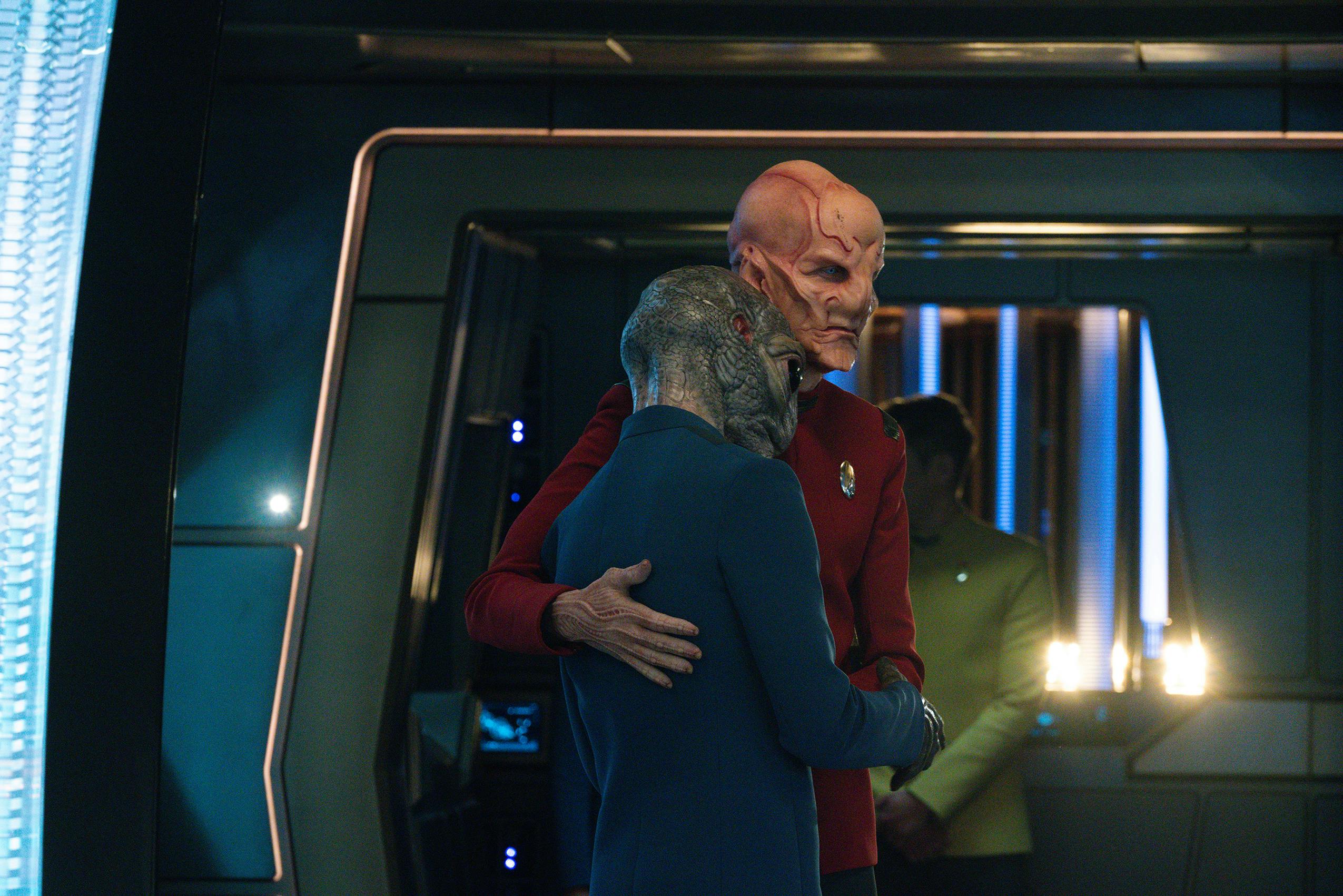
Across the room, Admiral Charles Vance approaches Captain Burnham and hands her an infinity-shaped device. The two retreat to a secure location — a featureless, all-white area known as the Infinity Room — and rendezvous with Dr. Kovich, who acknowledges the facility’s over-the-top theatricality. Turning to Burnham, Vance explains that an 800-year old science vessel was just found at the edge of the Beta Quadrant. Discovery needs to jump there immediately, but Kovich will only say that the ship contains "something vital to the security of the Federation." Burnham begins to object, but Kovich silences any disagreement when he reveals that the mission is a Red Directive.
Saru beams into Discovery 's Bridge and receives status reports from Lt. Christopher, Lt. Linus, Lt. Commander Joann Owosekun, Lt. Naya, Lt. Commander Gen Rhys, and Lt. Commander Keyla Detmer. Burnham and Kovich transport aboard and share that the crew will be going on a Red Directive classified mission. Their target? A 24th Century Romulan science vessel that will most certainly attract the attention of scavengers and other nefarious characters. A second Starfleet ship is already en route, but Discovery will arrive first — or so they believe…
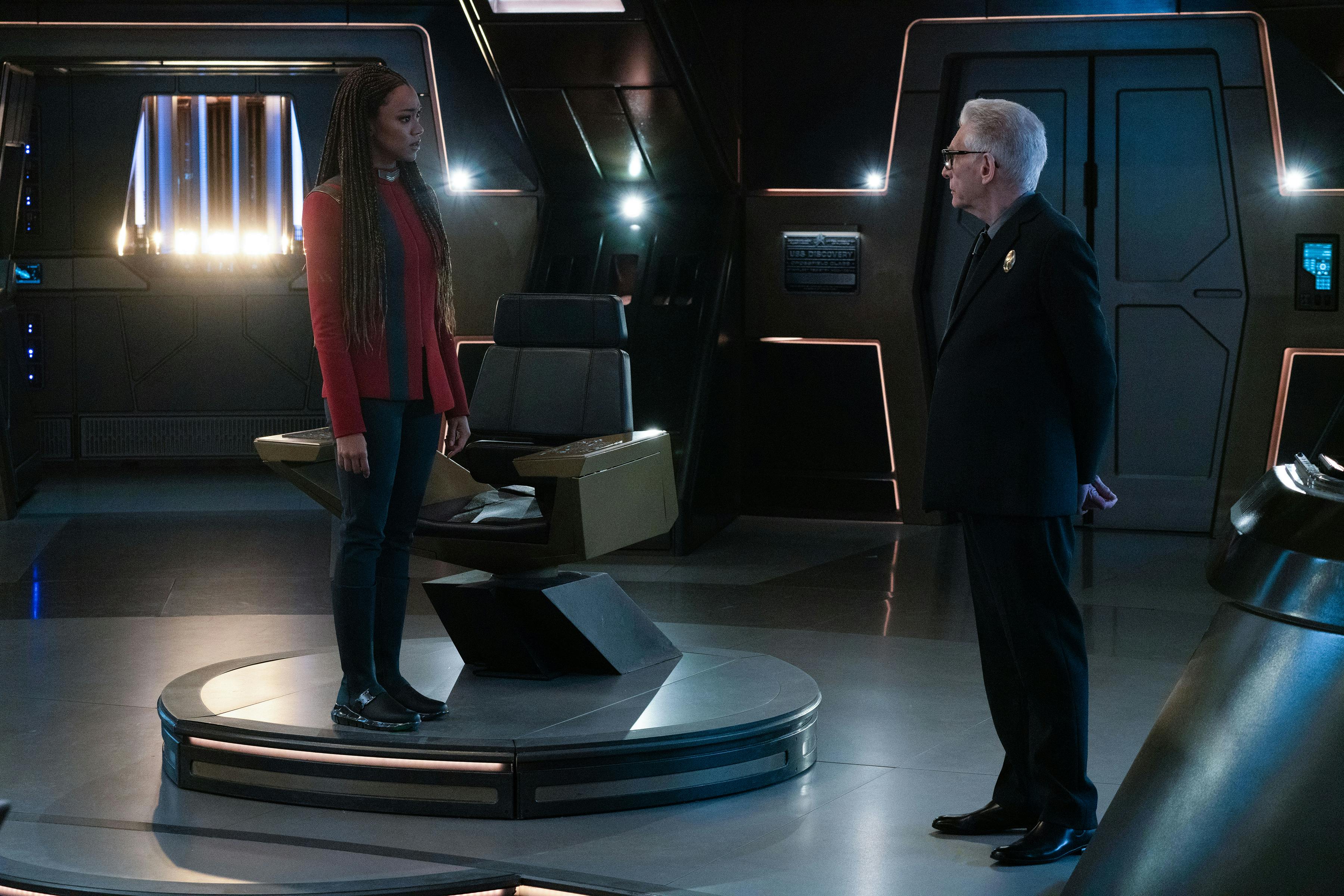
Across the quadrant, two helmeted figures pillage the derelict Romulan starship, ultimately removing their protective gear and taking in the ship’s breathable atmosphere. The female — Moll — comments that the U.S.S. Antares is on its way, and her male cohort L’ak sees a second Starfleet ship on their scanners. L’ak believes this means that the Romulan cargo must be "extra shiny," but he suggests they call it a day and enjoy a holodeck for two. Moll asks if L’ak wants "the pebbles or the mountain," convincing her partner to stay the course.
Discovery enters scanning range, and Owosekun detects two lifeforms on the Romulan ship — at least until their lifesigns suddenly vanish. Burnham gathers Owosekun and Rhys for the away team, but Kovich offers some disturbing insight — setting weapons to stun might not be enough, so they are authorized to use lethal force. Shock covers Burnham's face, and Kovich orders her to successfully complete the mission by any means necessary.
The three Starfleet officers beam over to the Romulan vessel's darkened corridors with phasers drawn and begin searching for the trespassers. Aerosolized water droplets notify them that the intruders had not been gone long, and Burnham advises Rhys and Owosekun to keep their phasers on stun. The trio continue on and locate an 800-year old Romulan corpse and an uncloaked — and empty — vault. Realizing the scavengers must be close, the Starfleet officers spin around and open fire. Moll and L'ak materialize in front of them, managing to capture Rhys and Owosekun in containment fields and making their escape.
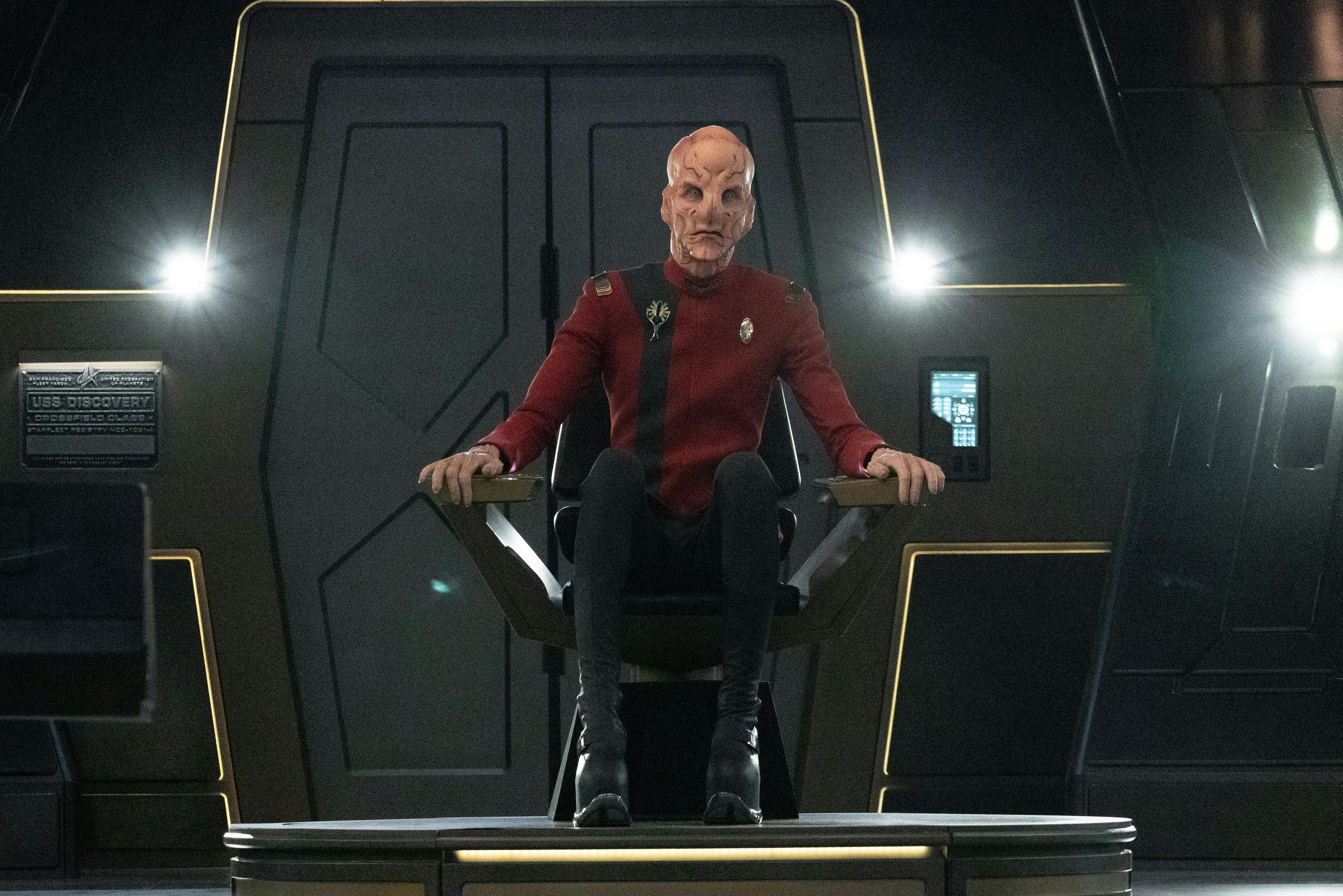
Captain Burnham pursues, converting her weapon into a phaser rifle and exchanging volleys with her opponents. Moll and L'ak step forward, holding the prize they acquired from the vault and tossing an explosive charge toward the captain. As the intruders beam away, Burnham is tossed through an opening and into space. Fortunately, her programmable matter EV suit automatically activates, and the captain jets toward the outline of Moll and L'ak's ship. Burnham magnetizes her suit as the craft enters warp.
As Burnham works to sabotage the engines, the U.S.S. Antares follows and grabs the ship with a tractor beam. Captain Rayner signals Burnham, who notices the warp bubble has started to collapse and urges the U.S.S. Antares to release its hold on the fleeing vessel. Operating on Burn-era tech and lacking a state-of-the-art Pathway Drive, Rayner knows the Antares can’t pull the enemy craft out of warp. Having previously encountered Moll and L'ak, Rayner is hesitant to let them elude him
Checking in from Discovery 's center seat, Saru informs Burnham — who doesn’t want to miss her upcoming saxophone lesson — that Owosekun and Rhys are being treated in Sickbay. Detmer pilots the Crossfield -class vessel into position and Lt. Gallo prepares to transport the captain to safety. The ride is bumpy, but Kovich resolves to remain on the Bridge until the mission is completed. Burnham repeats her warning to Rayner, advising that the breakup of Moll's ship would also destroy the Antares . Believing that every mission is personal, Rayner pushes back on Burnham's own record, but he eventually concedes.
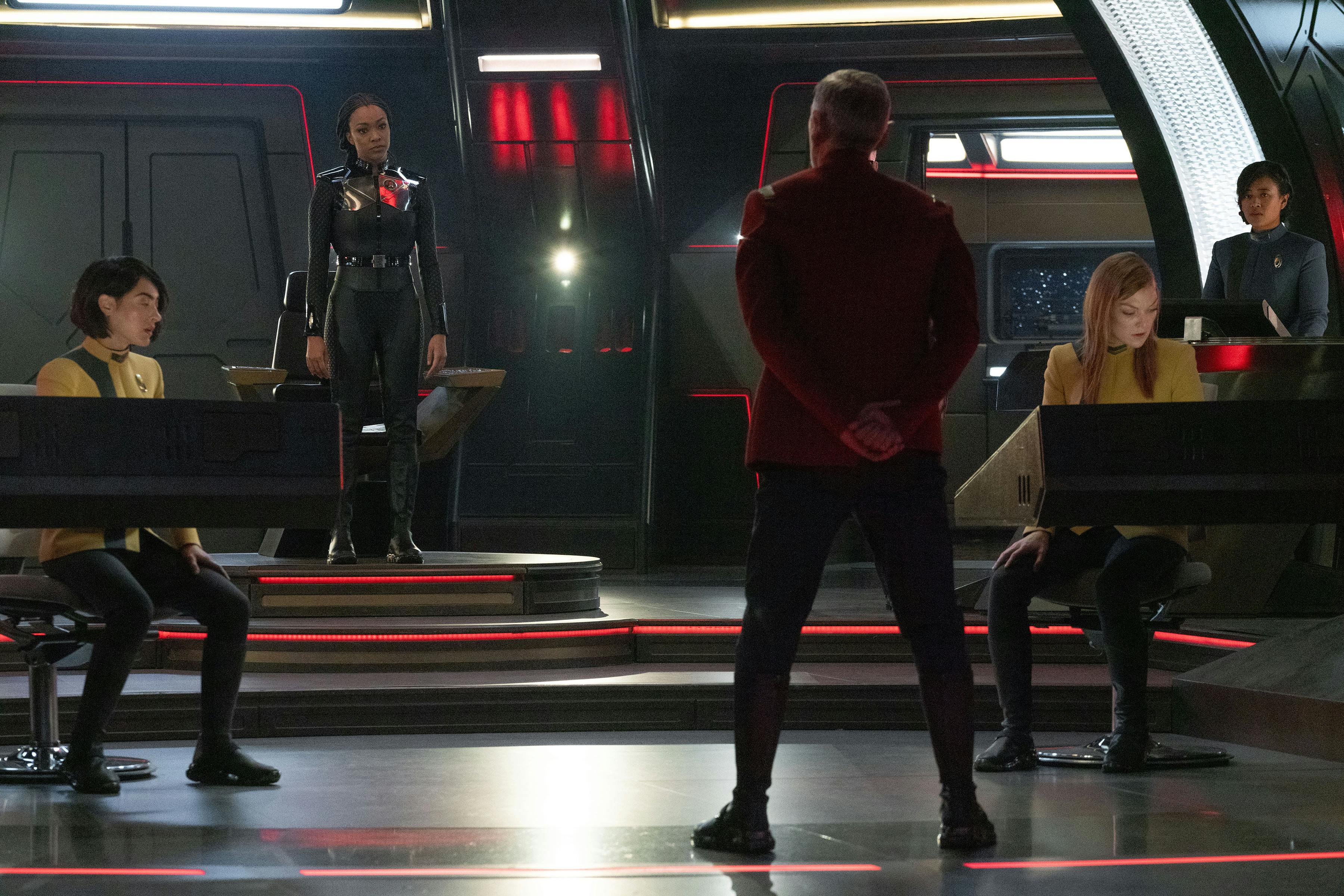
The three starships, as well as Captain Burnham, drop out of warp. The intruders' vessel spouts numerous probes, and they all leap to warp on different courses. Burnham is beamed right to Discovery 's Bridge, barely able to catch her breath before Rayner's hologram appears to discuss what he describes as the "cherry that they just dropped on our shit sundae." Appearing with a stern face and pointed ears, Rayner states that the probes left behind 20 warp signatures, meaning it will take days to determine which course Moll and L'ak actually took. Kovich voices his displeasure, but Burnham admits she knows someone who can help them find the thieves.
Discovery jumps to a ringed planet, and its captain nervously strolls into the shuttlebay to greet Cleveland "Book" Booker, who beams in and requests permission to come aboard. The somewhat awkward reunion shifts into Discovery 's corridors, where Burnham announces her suspicion that Moll and L'ak used to be couriers. The Federation is expanding and most of the old networks are closed, but Burnham hopes Book's experience, expertise, and insight can assist them in determining the correct warp signature. The two acknowledge that it has been a while since they spoke, and Burnham commends him for the work he has done with the refugees who were affected by the Dark Matter Anomaly. Book is eager to "make things right" in the wake of stealing the experimental spore drive for his own ship.
Burnham and Book confer with Saru, Kovich, Vance, and Rayner in the Ready Room, where the Antares ' captain briefs them on what is known about Moll — a human — and L'ak, a member of an unknown species. The duo, who showed up in the sector approximately two years ago, procured a tan zhekran — a traditional Romulan puzzle box — from the science ship. Kovich claims he is not at liberty to share details about the item and shifts the conversation to Book's detective skills. Factoring in the need to avoid Federation territory and the few fencers who would have interest in a 24th Century haul, Book determines that Moll and L'ak are headed to meet with a broker named Fred — just "Fred" — on Q’Mau. Vance orders Burnham and Rayner to investigate, insisting that they try working together.
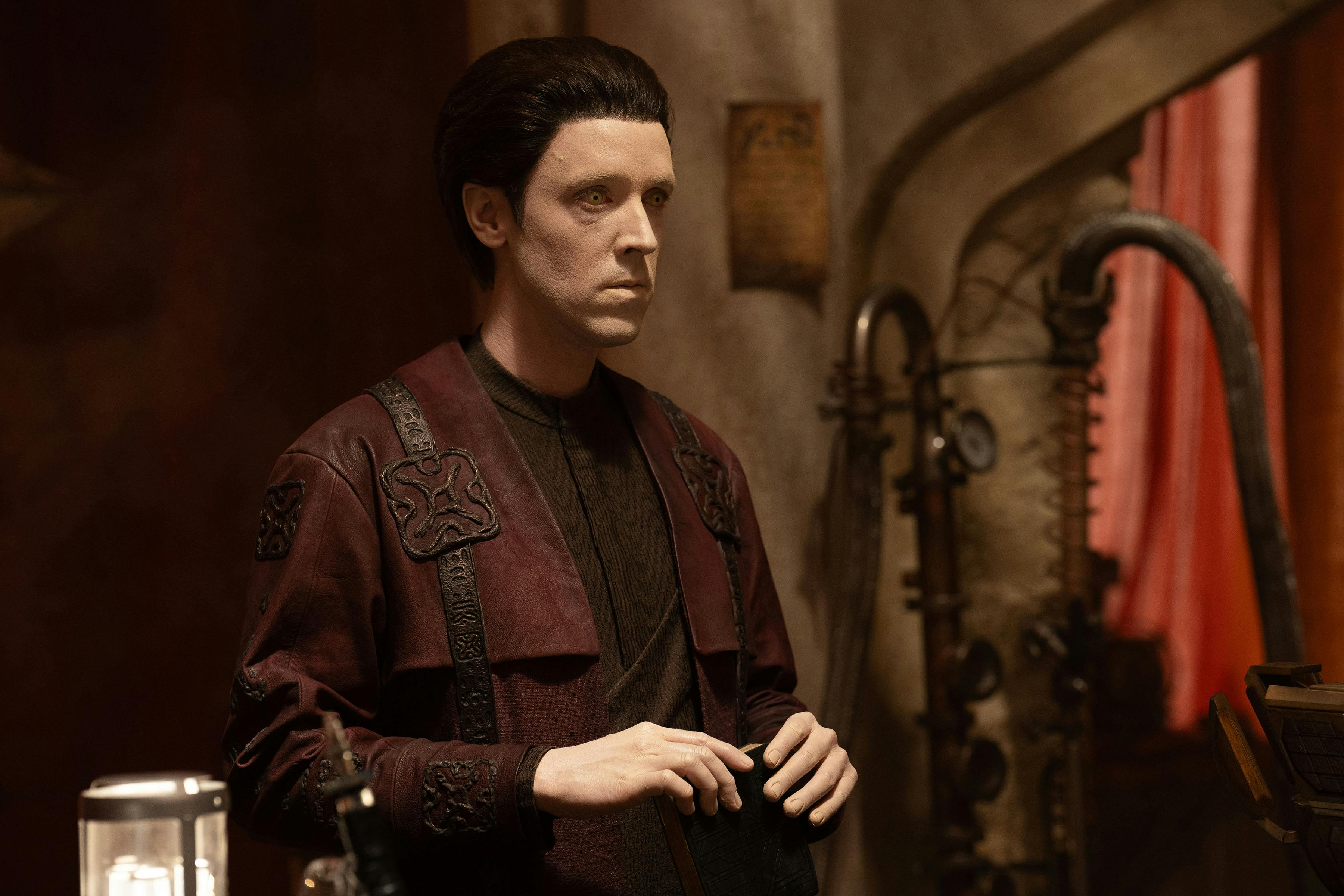
The officers begin to walk out, but Saru stays behind to speak with Captain Burnham in private. Noting that a tan zhekran can contain almost anything, including a weapon or a pathogen, the captain is concerned that Kovich won't even tell her the name of the Romulan scientist who owned it. Saru slyly suggests that someone outside of Discovery 's chain of command with access to different databases might be able to assist. Burnham responds with a joyous smile, her expression turning serious as she remembers Saru could soon be leaving for another post.
Back at Federation HQ, Lt. Tilly enters her quarters in the midst of an energetic chat with Lt. Jax. Lamenting over a cadet who refuses to leave the lab during the Academy's Simulation Week, Tilly outlines collaboration's importance to Starfleet's future and — very briefly — ponders whether she could crash every cadet onto an ice moon in order to teach them that lesson. Tilly attributes her talkativeness to the champagne served at the after party, and the two officers exchange flirtatious gazes.
Tilly and Jax — who both love walking and talking — share a clumsy goodbye that nevertheless elicits a smirk from the Academy instructor. Now alone, Tilly orders up a coffee from the replicator. The respite is short-lived, as an incoming communication from Captain Burnham provides another boost to Tilly's energy reserves. Theorizing that Tilly must have had some Andorian champagne, Burnham adopts her "serious voice" and asks Tilly for her help. Always available for her friends, Tilly gleefully responds, "Whatever it is, I’m in."
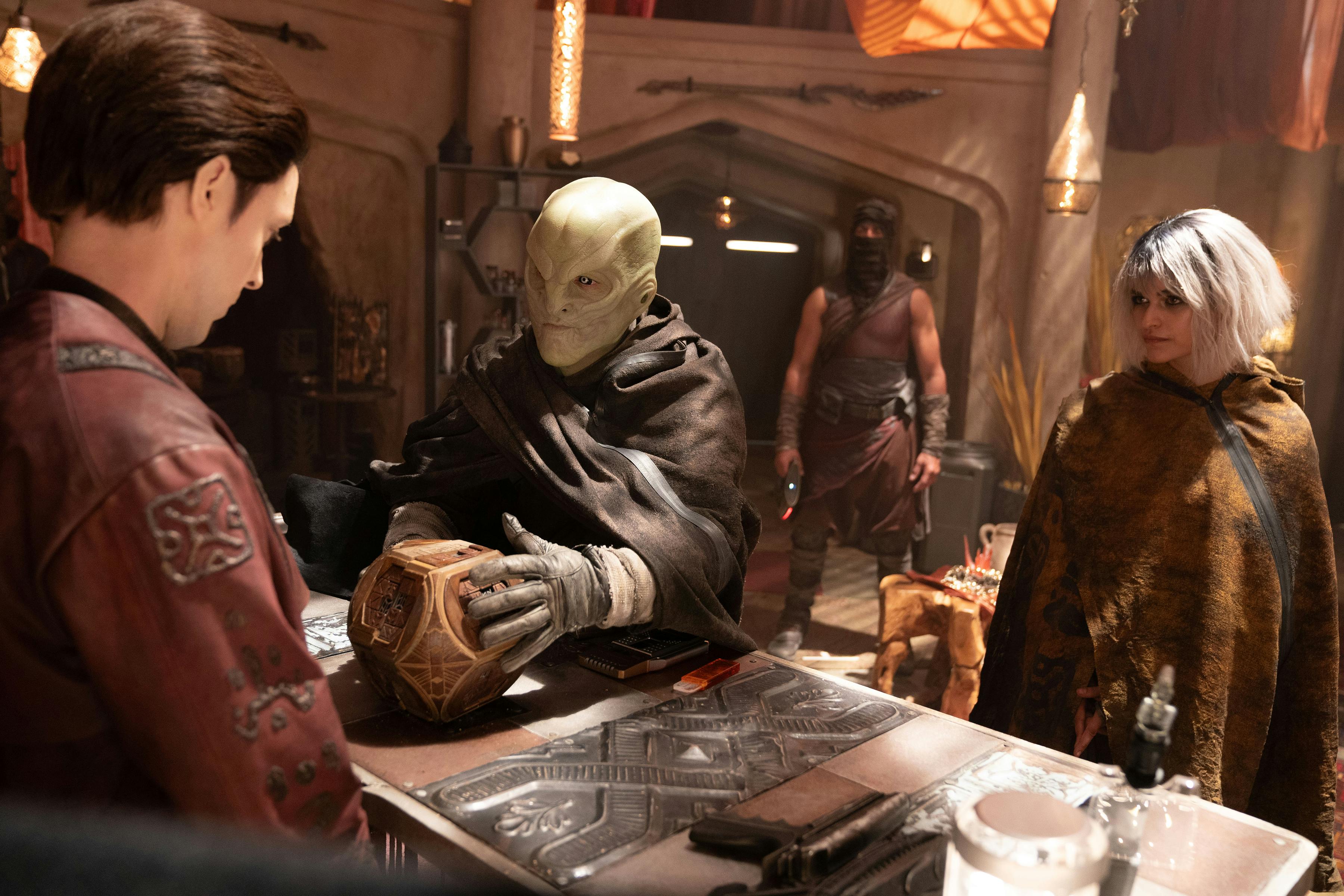
Discovery arrives at Q’Mau, where Burnham and Book beam down to a small settlement that is surrounded by a desert landscape and rocky outcroppings. Book remarks that it feels like their old courier days, and Burnham asks about Grudge — the Queen is great, she says, "Hi." They disagree about who should have made more of an effort to contact the other, but Rayner's arrival disperses the mounting tension.
Elsewhere in the marketplace, Moll and L'ak are scanned and welcomed into Fred's establishment. Fred, who has the distinctive appearance of a synthetic lifeform, maintains a friendly demeanor, though his guards supply the room with an air of hostility. Fred notices Moll and L'ak's "togetherness," spiritedly contrasting the bilabial nasal of "Moll" with the voiceless velar plosive of "L'ak." The thieves present Fred with their recent finds — isolinear coprocessors, vintage PADDS and tricorders, self-sealing stem bolts, and the mysterious puzzle box.
Intrigued, Fred mentions that he hasn’t encountered such an item in 622.7 years. He unlocks the box by shifting its features into a new configuration, revealing a handwritten diary. The android skims the text, happily offering Moll and L'ak three bars of latinum for the entire lot. The duo replies with a laugh, unsatisfied with the price. Fred refuses to return their items, prompting the pair to burst into hand-to-hand combat with his guards. Moll is struck by an energy blast from the synth’s weapon, and — though her wound is not fatal — L'ak launches into a violent frenzy that results in Fred’s demise.
Book, Burnham, and Rayner locate Fred's lair soon after and confiscate the synth's body so that Discovery can scan his memory. Rayner hurriedly sets off on his own, but Book and Burnham remain to plot their next move. As they realize that Moll and L'ak must have cloaked their ship outside the settlement, Dr. Culber observes Fred's corpse in Sickbay. The android is an old model — dozens of generations before the tech used for Gray’s body — marked with the serial number "AS0572Y." Stamets deduces that the "AS" was intended to honor Altan Soong*, marveling at the 24th Century scientist’s legacy. The astromycologist needs wires to interface with Fred's memory drive, quipping that — luckily — Culber had married a packrat.
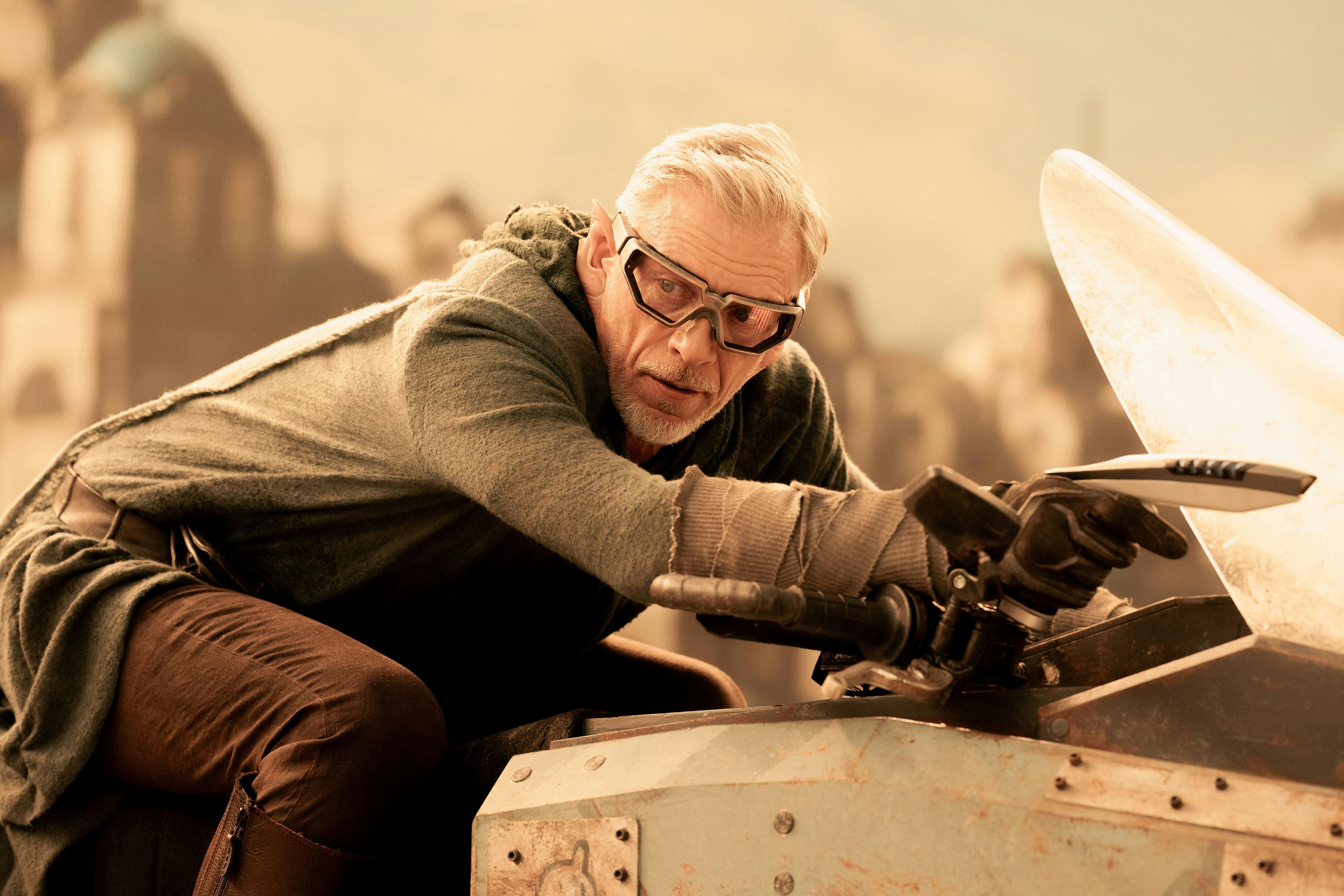
Down on the planet's surface, Moll and L'ak speed by Rayner on sand runners — swift transports used by locals to navigate the terrain. Thanks to their patience and foresight, Burnham and Book had anticipated the chase and already rented three of the vehicles. Rayner isn't impressed by Burnham's "strategic advantages," leaving Discovery 's captain to tell Book that she hasn’t disliked someone this much in 930 years.
Meanwhile, at Federation HQ, two security officers burst into Tilly's quarters as the lieutenant prepares to break the shifting fractal encryption which safeguards a secure Federation database. Vance marches in and intervenes, who astonishingly agrees that Captain Burnham deserves to know why her crew is risking their lives for an 800-year old Romulan ship. The admiral says that it is a "shame" he didn't get to stop Tilly in time and allows her to unlock the file. A shaky holo-recording manifests, depicting Doctor Vellek* — the Romulan whose body they had found. The Romulan scientist warns that his knowledge of an ancient technology beyond all comprehension — hidden in the "shadow of twin moons" — must not be lost or fall into the wrong hands.
On Q’Mau, the Starfleet officers close in on Moll and L'ak, but Rayner ventures ahead once again. Book teases Burnham by claiming that Rayner reminds him of another captain he knows, but the situation intensifies once the thieves reach their starship. Moll and L'ak set course for a nearby mountain's tunnel system so as to avoid detection by Discovery and Antares , and sensors detect an explosive charge in one of the tunnel's entrances. Aware that their foes planned ahead to distract their pursuers with an avalanche. According to Saru, Zora estimates there to be a 30% chance that the disaster would decimate the settlement.
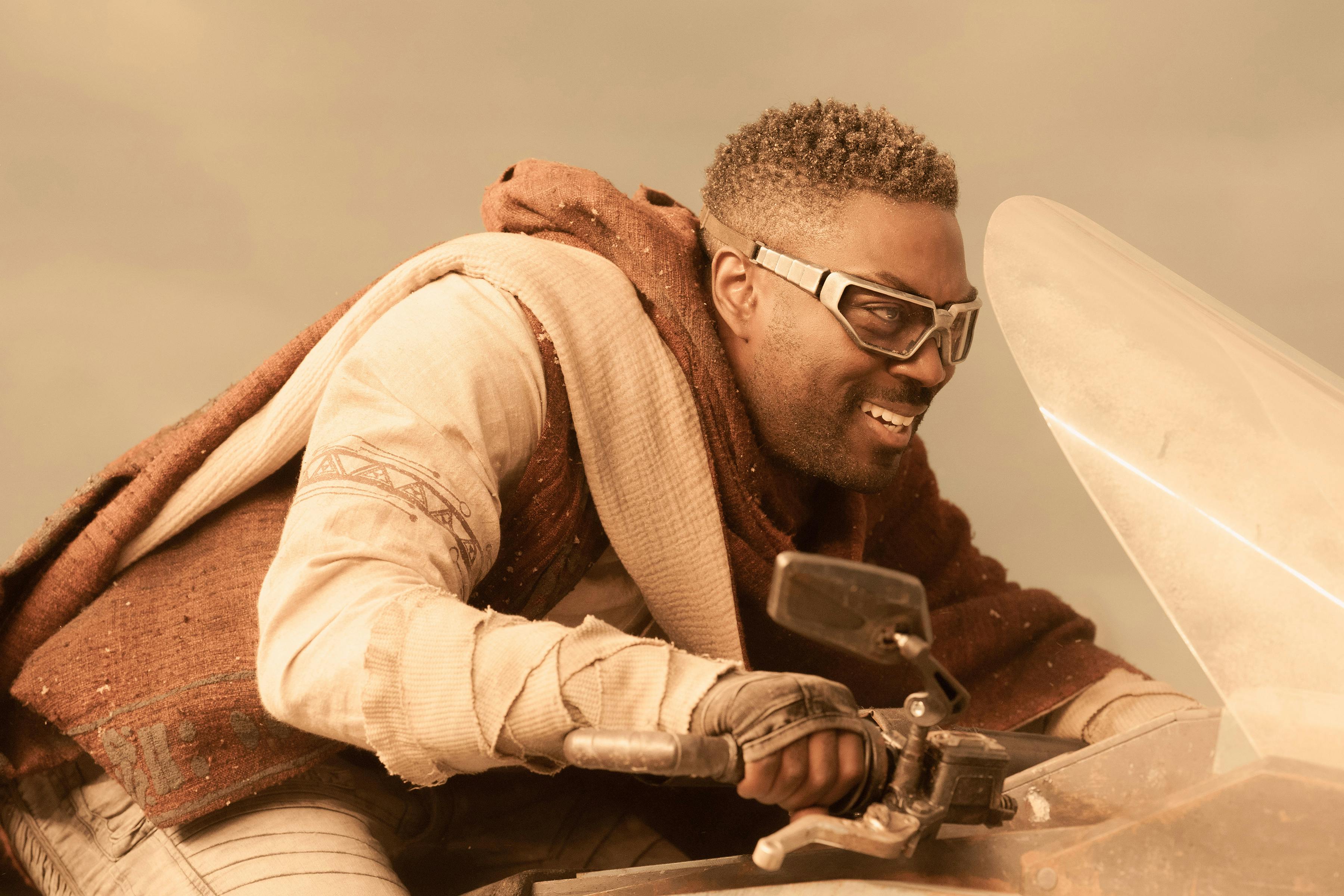
Captain Rayner proposes an unorthodox plan — detonate the charge themselves and block Moll and L'ak's escape route. Burnham disagrees, yet her counterpart insists that she is letting stats get in the way of strategy — though possible, an avalanche is unlikely. As Rayner orders Antares to lock phasers on target, Burnham contends that they are on a non-Federation planet and undertaking a classified mission, but Rayner follows through with his plan. Phaser beams strike down from orbit and seal the tunnel, yet Saru confirms that scans show the mountainside remains stable… at least until Moll and L'ak launch a photon torpedo that sends the rattled cliff into a freefall.
Burnham, Book, and Rayner flee from the rising debris cloud on their sand runners, but Zora announces that the avalanche is reaching speeds of 200 kilometers per hour — there is not enough time to evacuate the local encampment. In Engineering, Stamets and Adira run through several solutions, ultimately landing on the idea of combining Discovery and Antares ' shields to serve as a "brake" for the avalanche. Will it work? Stamets thinks — no, hopes — it will work, finally deciding, "Let’s go with 'hope.'"
Captain Saru starts to organize the maneuver, but Rayner does not want Antares to leave orbit and lose track of Moll and L'ak. Burnham emphasizes that the safety of the civilians in the avalanche's path is now their primary mission, and Rayner relents. Discovery and Antares burst through the atmosphere in a tight formation, fusing their shields together and burying their forward saucers into the planet's desert. The avalanche ripples against the energy barrier, but the starships triumphantly hold the line and inspire cheers from the settlement. The relief is lost on Rayner, who watches as Moll and L'ak escape to warp.
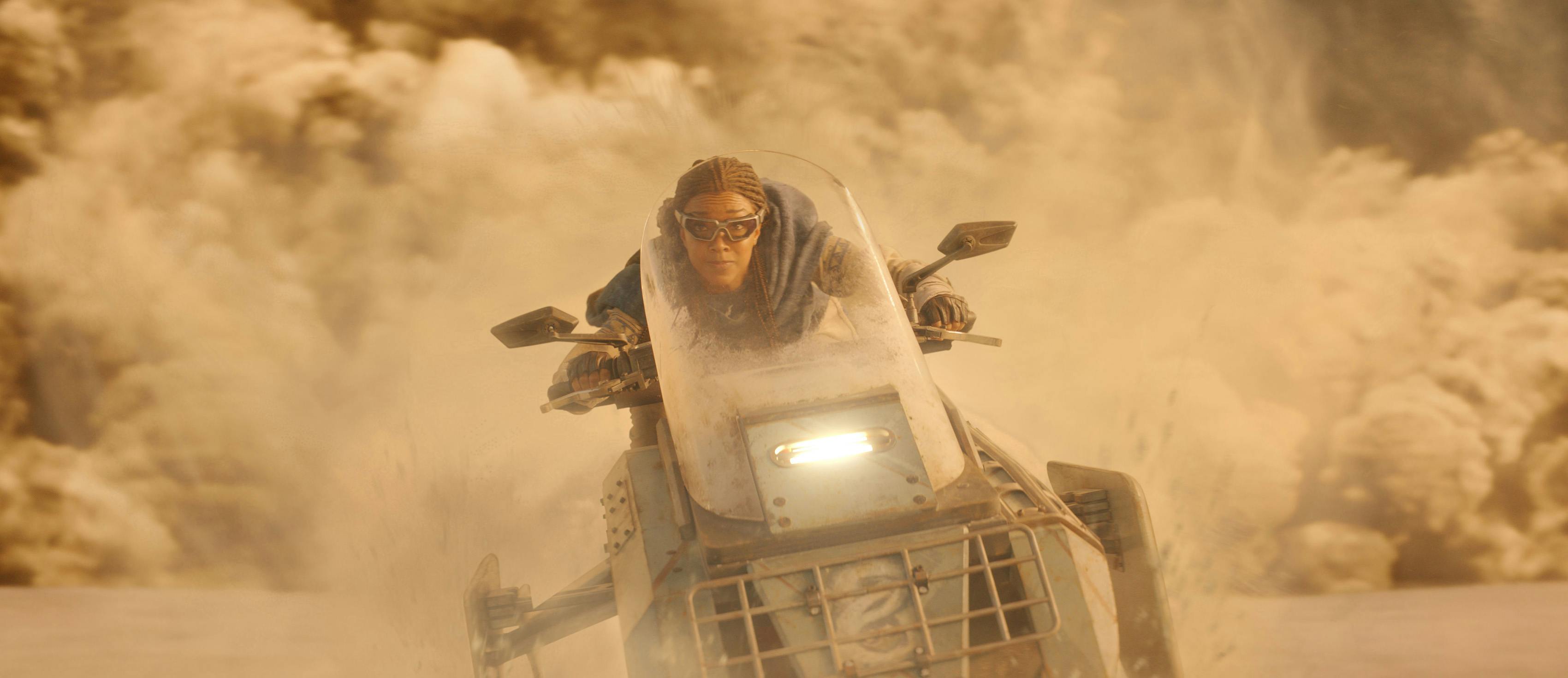
Rayner beams back to the Antares , giving Burnham and Book a moment to enjoy each other's company and confess that they both should have called one another. Still bruised from the ordeal, Burnham takes her admission a step further and reveals that she's not sure how to be around him anymore. Book considers the statement, countering that some things are hard to move past. The heart-to-heart is interrupted by a transmission from Tilly, who tells the captain that she has "wild" answers to her pressing questions.
The Discovery -A employs its spore drive to return to Federation Headquarters, where Captain Saru resolves to have his own private conversation with his partner. T'Rina expresses concern over rumors of Saru's eventful mission. The Kelpien reflects on the danger the civilians had faced and recalls something Tilly had once told him — "life is just a blink." Saru struggles to elaborate, aware that fear had constrained him from embracing love while dealing with the cullings of his youth.***
Had he been endangered by the avalanche, Saru would only have been able to think of T'Rina, therefore their relationship must be factored in as he considers his future. T'Rina is his home, his family, and so much more, and he intends to accept the ambassadorship to be alongside her — always. T’Rina welcomes the news, pleasantly surprising Saru when she proposes they "codify" their bond through marriage.
On Discovery , Captain Burnham enters Sickbay to get an update on Fred from Culber and Stamets. They downloaded the last 15 teraquads of data from his ocular processing unit, giving them an extended look at the pages of Vellek's diary. A handwritten diagram depicting the Vileen system's "twin moons" catches the captain's attention, sending her on a mission to meet Kovich on a holographic representation of a barren planetary surface. Kovich admires her tenacity but claims this Red Directive has been classified for centuries. His threat to pass the assignment to another team doesn't phase Burnham, who knows she holds the key to their target's location.
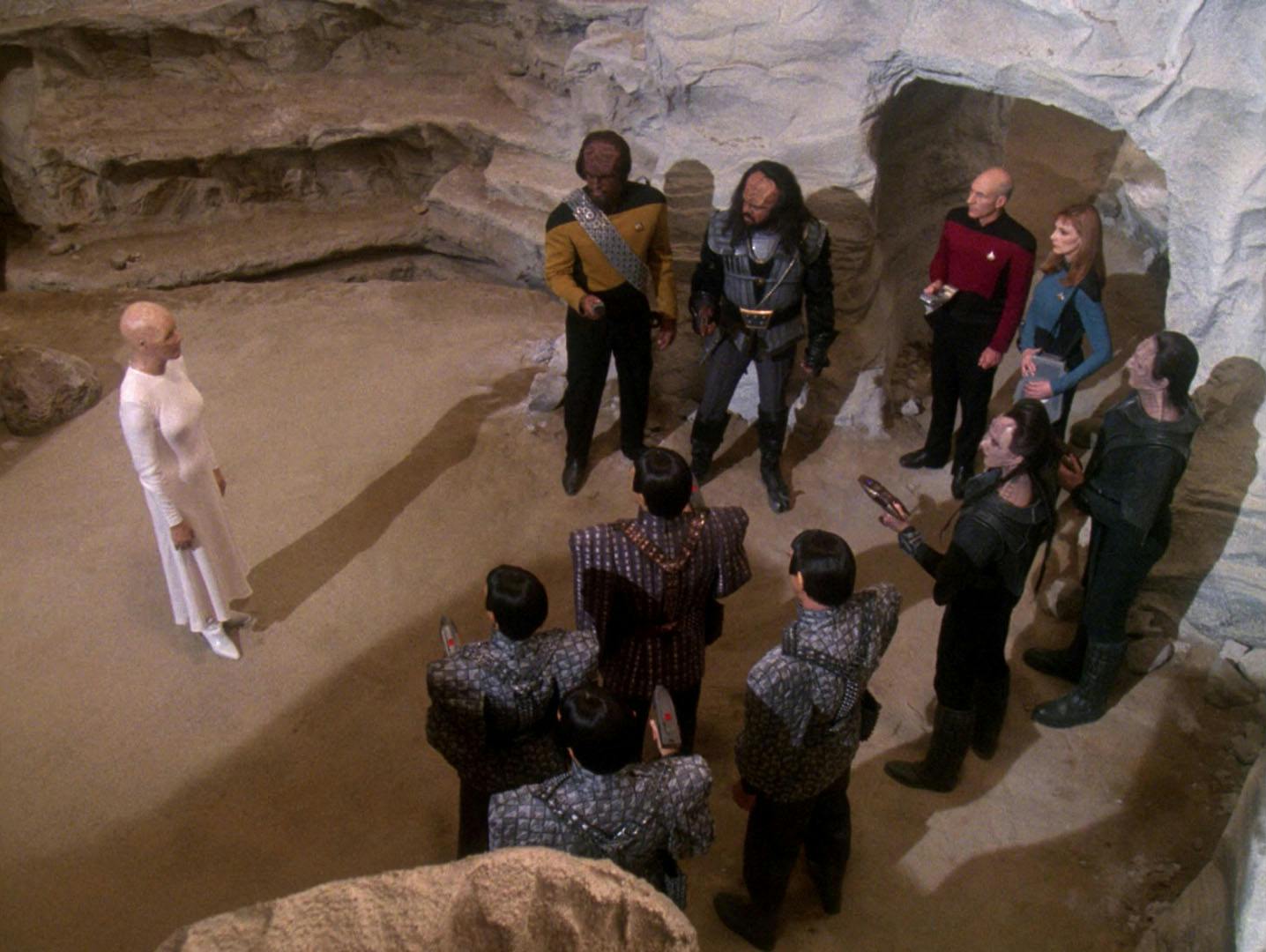
"The Chase"
Kovich lets out a sheepish grin, aware that Tilly and Vance played key parts in briefing the captain. He discontinues the holo, and — as the two stand in his office — he recounts the details. As one of the greatest scientists of his day, Dr. Vellek, was present when a Starfleet captain — Jean-Luc Picard — found a message left by a race of ancient beings — referred to as the "Progenitors" — who created every humanoid species in the galaxy.** Vellek discovered the technology that the Progenitors used to design life itself, but its location was lost when he disappeared 800 years ago.
Now, either Moll and L'ak know where this powerful find is or the diary is the first piece of the puzzle. Starfleet must track down this technology to prevent it from falling into the wrong hands. Burnham divulges that Lyrek, a planet situated in an outer sector of the Beta Quadrant within the Vileen system, has three moons — two of which move in perfect sync. Pleased, Kovich proclaims that the greatest treasure in the known galaxy is out there, lightheartedly asking the captain what she’s waiting for. Burnham flashes a smile and replies, "Let’s fly."

* " Et in Arcadia Ego, Part 1 " — The dealer in Q'Mau, Fred, is a Soong-inspired synthetic possessed a memory drive that had a serial number with an attribution to Altan Soong. The self-described "mad scientist" is the son of Noonien Soong , the creator of Soong-type androids. Altan Soong would continue his work despite the Federation's ban on synths. His work (and Dr. Maddox's research), known as the Soong Method, on transferring sentience into an artificial golem body was what helped create Gray Tal's new synthetic body's design in "Anomaly."
** " The Chase " — This Star Trek: The Next Generation adventure was where Captain Jean-Luc Picard found himself in a race with the Cardassians, Klingons, and Romulans to solve a four billion year old genetic puzzle. The Romulan Dr. Vellek, one of the greatest scientists of his day, was among those present when Picard discovered a message left by a race of ancient beings known as Progenitors, who created life as we know it — every humanoid species in the galaxy.
*** " An Obol for Charon " — Following Saru's survival of Vahar'ai , he discovered that the maturation process didn't signal death. It was in fact a biological event in the Kelpien's evolution that removed their suppression of fear. Concerned with their own survival, the Ba'ul who lived on Kaminar with Kelpiens exploited their binary nature to oppress the later group.

- Written by Michelle Paradise
- Directed by Olatunde Osunsanmi

"Red Directive" features a dedication:
For JP, with love.
Get Updates By Email
Jay Stobie (he/him) is a freelance writer, author, and consultant who has contributed articles to StarTrek.com, Star Trek Explorer, and Star Trek Magazine, as well as to Star Wars Insider and StarWars.com. Learn more about Jay by visiting JayStobie.com or finding him on Twitter, Instagram, and other social media platforms at @StobiesGalaxy.
Star Trek: Discovery Seasons 1-4 are streaming exclusively on Paramount+ in the U.S., the UK, Canada, Switzerland, South Korea, Latin America, Germany, France, Italy, Australia and Austria. Seasons 2 and 3 also are available on the Pluto TV “Star Trek” channel in Switzerland, Germany and Austria. The series streams on Super Drama in Japan, TVNZ in New Zealand, and SkyShowtime in Spain, Portugal, Poland, The Nordics, The Netherlands, and Central and Eastern Europe and also airs on Cosmote TV in Greece. The series is distributed by Paramount Global Content Distribution.
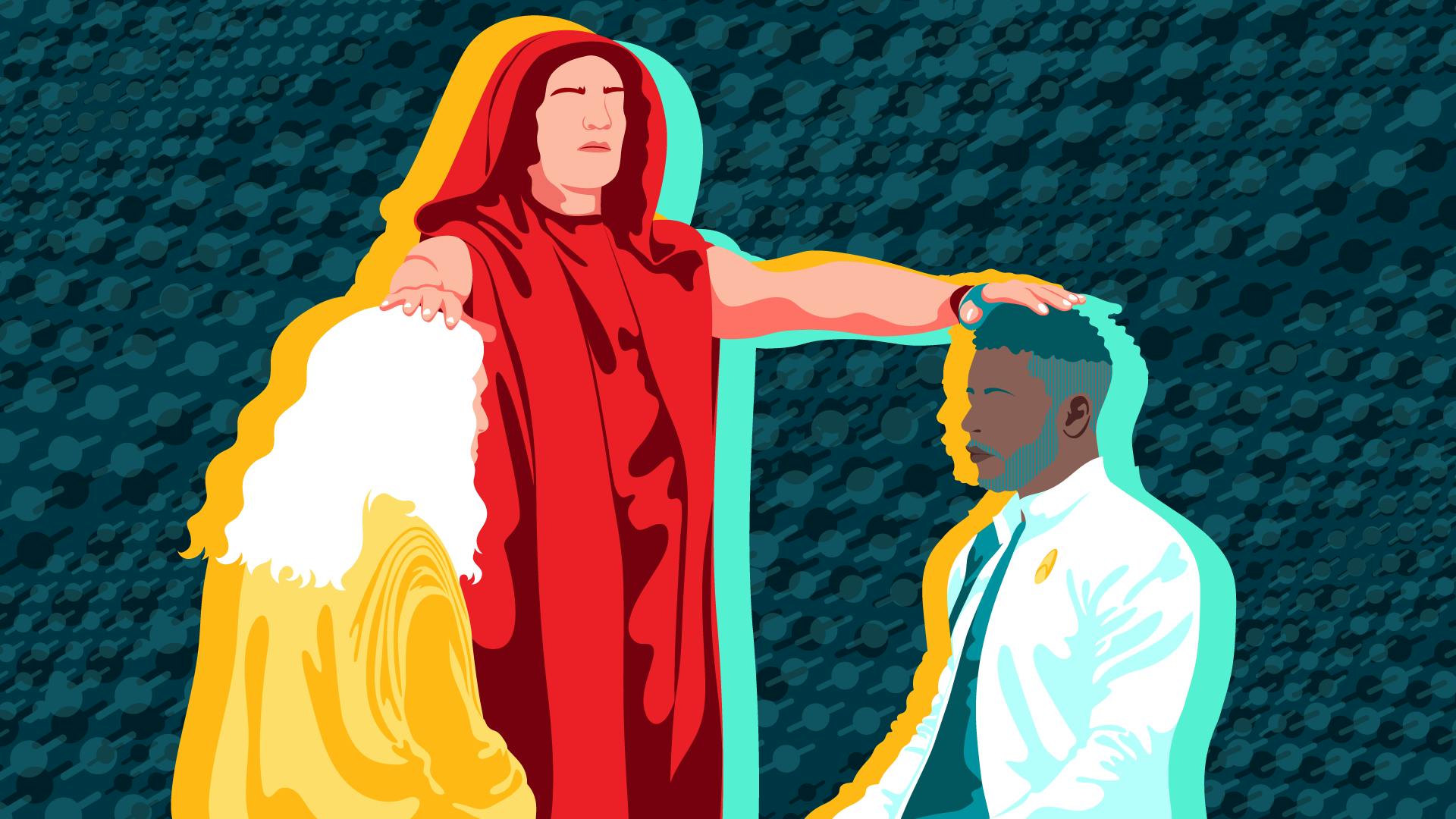
Most massive stellar black hole in our galaxy found
Astronomers have identified the most massive stellar black hole yet discovered in the Milky Way galaxy. This black hole was spotted in data from the European Space Agency's Gaia mission because it imposes an odd 'wobbling' motion on the companion star orbiting it. Data from the European Southern Observatory's Very Large Telescope (ESO's VLT) and other ground-based observatories were used to verify the mass of the black hole, putting it at an impressive 33 times that of the Sun.
Stellar black holes are formed from the collapse of massive stars and the ones previously identified in the Milky Way are on average about 10 times as massive as the Sun. Even the next most massive stellar black hole known in our galaxy, Cygnus X-1, only reaches 21 solar masses, making this new 33-solar-mass observation exceptional [1].
Remarkably, this black hole is also extremely close to us -- at a mere 2000 light-years away in the constellation Aquila, it is the second-closest known black hole to Earth. Dubbed Gaia BH3 or BH3 for short, it was found while the team were reviewing Gaia observations in preparation for an upcoming data release. "No one was expecting to find a high-mass black hole lurking nearby, undetected so far," says Gaia collaboration member Pasquale Panuzzo, an astronomer at the Observatoire de Paris, part of France's National Centre for Scientific Research (CNRS). "This is the kind of discovery you make once in your research life."
To confirm their discovery, the Gaia collaboration used data from ground-based observatories, including from the Ultraviolet and Visual Echelle Spectrograph (UVES) instrument on ESO's VLT, located in Chile's Atacama Desert [2]. These observations revealed key properties of the companion star, which, together with Gaia data, allowed astronomers to precisely measure the mass of BH3.
Astronomers have found similarly massive black holes outside our galaxy (using a different detection method), and have theorised that they may form from the collapse of stars with very few elements heavier than hydrogen and helium in their chemical composition. These so-called metal-poor stars are thought to lose less mass over their lifetimes and hence have more material left over to produce high-mass black holes after their death. But evidence directly linking metal-poor stars to high-mass black holes has been lacking until now.
Stars in pairs tend to have similar compositions, meaning that BH3's companion holds important clues about the star that collapsed to form this exceptional black hole. UVES data showed that the companion was a very metal-poor star, indicating that the star that collapsed to form BH3 was also metal-poor -- just as predicted.
The research study, led by Panuzzo, is published today in Astronomy & Astrophysics. "We took the exceptional step of publishing this paper based on preliminary data ahead of the forthcoming Gaia release because of the unique nature of the discovery," says co-author Elisabetta Caffau, also a Gaia collaboration member from the CNRS Observatoire de Paris. Making the data available early will let other astronomers start studying this black hole right now, without waiting for the full data release, planned for late 2025 at the earliest.
Further observations of this system could reveal more about its history and about the black hole itself. The GRAVITY instrument on ESO's VLT Interferometer, for example, could help astronomers find out whether this black hole is pulling in matter from its surroundings and better understand this exciting object.
[1] This is not the most massive black hole in our galaxy -- that title belongs to Sagittarius A*, the supermassive black hole at the Milky Way's centre, which has about four million times the mass of the Sun. But Gaia BH3 is the most massive black hole known in the Milky Way that formed from the collapse of a star.
[2] Aside from UVES on ESO's VLT, the study relied on data from: the HERMES spectrograph at the Mercator Telescope operated at La Palma (Spain) by Leuven University, Belgium, in collaboration with the Observatory of the University of Geneva, Switzerland; and the SOPHIE high-precision spectrograph at the Observatoire de Haute-Provence -- OSU Institut Pythéas.
- Black Holes
- Astrophysics
- Solar Flare
- Extrasolar Planets
- Space Telescopes
- Spitzer space telescope
- Holographic Universe
- Interstellar medium
Story Source:
Materials provided by ESO . Note: Content may be edited for style and length.
Related Multimedia :
- Artist’s impression of the system with the most massive stellar black hole in our galaxy
Journal Reference :
- P. Panuzzo, T. Mazeh, F. Arenou, B. Holl, E. Caffau, A. Jorissen, C. Babusiaux, P. Gavras, J. Sahlmann, U. Bastian, Ł. Wyrzykowski, L. Eyer, N. Leclerc, N. Bauchet, A. Bombrun, N. Mowlavi, G.M. Seabroke, D. Teyssier, E. Balbinot, A. Helmi, A.G.A. Brown, A. Vallenari, T. Prusti, J.H.J. de Bruijne, A. Barbier, M. Biermann, O.L. Creevey, C. Ducourant, D.W. Evans, R. Guerra, A. Hutton, C. Jordi, S.A. Klioner, U. Lammers, L. Lindegren, X. Luri, F. Mignard, C. Nicolas, S. Randich, P. Sartoretti, R. Smiljanic, P. Tanga, N.A. Walton, C. Aerts, C.A.L. Bailer-Jones, M. Cropper, R. Drimmel, F. Jansen, D. Katz, M.G. Lattanzi, C. Soubiran, F. Thévenin, F. van Leeuwen, R. Andrae, M. Audard, J. Bakker, R. Blomme, J. Castañeda, F. De Angeli, C. Fabricius, M. Fouesneau, Y. Frémat, L. Galluccio, A. Guerrier, U. Heiter, E. Masana, R. Messineo, K. Nienartowicz, F. Pailler, F. Riclet, W. Roux, R. Sordo, G. Gracia-Abril, J. Portell, M. Altmann, K. Benson, J. Berthier, P.W. Burgess, D. Busonero, G. Busso, C. Cacciari, H. Cánovas, J.M. Carrasco, B. Carry, A. Cellino, N. Cheek, G. Clementini, Y. Damerdji, M. Davidson, P. de Teodoro, L. Delchambre, A. Dell'Oro, E. Fraile Garcia, D. Garabato, P. García-Lario, R. Haigron, N.C. Hambly, D.L. Harrison, D. Hatzidimitriou, J. Hernández, D. Hestroffer, S.T. Hodgkin, S. Jamal, G. Jevardat de Fombelle, S. Jordan, A. Krone-Martins, A.C. Lanzafame, W. Löffler, A. Lorca, O. Marchal, P.M. Marrese, A. Moitinho, K. Muinonen, M. Nuñez Campos, I. Oreshina-Slezak, P. Osborne, E. Pancino, T. Pauwels, A. Recio-Blanco, M. Riello, L. Rimoldini, A.C. Robin, T. Roegiers, L.M. Sarro, M. Schultheis, M. Smith, A. Sozzetti, E. Utrilla, M. van Leeuwen, K. Weingrill, U. Abbas, P. Ábrahám, A. Abreu Aramburu, S. Ahmed, G. Altavilla, M.A. Álvarez, F. Anders, R.I. Anderson, E. Anglada Varela, T. Antoja, S. Baig, D. Baines, S.G. Baker, L. Balaguer-Núñez, Z. Balog, C. Barache, M. Barros, M.A. Barstow, S. Bartolomé, D. Bashi, J.-L. Bassilana, N. Baudeau, U. Becciani, L.R. Bedin, I. Bellas-Velidis, M. Bellazzini, W. Beordo, M. Bernet, C. Bertolotto, S. Bertone, L. Bianchi, A. Binnenfeld, S. Blanco-Cuaresma, J. Bland-Hawthorn, A. Blazere, T. Boch, D. Bossini, S. Bouquillon, A. Bragaglia, J. Braine, E. Bratsolis, E. Breedt, A. Bressan, N. Brouillet, E. Brugaletta, B. Bucciarelli, A.G. Butkevich, R. Buzzi, A. Camut, R. Cancelliere, T. Cantat-Gaudin, D. Capilla Guilarte, R. Carballo, T. Carlucci, M.I. Carnerero, J. Carretero, S. Carton, L. Casamiquela, A. Casey, M. Castellani, A. Castro-Ginard, L. Ceraj, V. Cesare, P. Charlot, C. Chaudet, L. Chemin, A. Chiavassa, N. Chornay, D. Chosson, W.J. Cooper, T. Cornez, S. Cowell, M. Crosta, C. Crowley, M. Cruz Reyes, C. Dafonte, M. Dal Ponte, M. David, P. de Laverny, F. De Luise, R. De March, J. De Ridder, A. de Torres, E.F. del Peloso, M. Delbo, A. Delgado, J.-B. Delisle, C. Demouchy, E. Denis, T.E. Dharmawardena, F. Di Giacomo, C. Diener, E. Distefano, C. Dolding, K. Dsilva, H. Enke, C. Fabre, M. Fabrizio, S. Faigler, M. Fatović, G. Fedorets, J. Fernández-Hernández, P. Fernique, F. Figueras, C. Fouron, F. Fragkoudi, M. Gai, M. Galinier, A. Garcia-Serrano, M. García-Torres, A. Garofalo, E. Gerlach, R. Geyer, P. Giacobbe, G. Gilmore, S. Girona, G. Giuffrida, A. Gomboc, A. Gomez, I. González-Santamaría, E. Gosset, M. Granvik, V. Gregori Barrera, R. Gutiérrez-Sánchez, M. Haywood, A. Helmer, S.L. Hidalgo, T. Hilger, D. Hobbs, C. Hottier, H.E. Huckle, Ó. Jiménez-Arranz, J. Juaristi Campillo, Z. Kaczmarek, P. Kervella, S. Khanna, M. Kontizas, G. Kordopatis, A.J. Korn, Á Kóspál, Z. Kostrzewa-Rutkowska, K. Kruszyńska, M. Kun, S. Lambert, A.F. Lanza, Y. Lebreton, T. Lebzelter, S. Leccia, G. Lecoutre, S. Liao, L. Liberato, E. Licata, E. Livanou, A. Lobel, J. López-Miralles, C. Loup, M. Madarász, L. Mahy, R.G. Mann, M. Manteiga, C.P. Marcellino, J.M. Marchant, M. Marconi, D. Marín Pina, S. Marinoni, D.J. Marshall, J. Martín Lozano, L. Martin Polo, J.M. Martín-Fleitas, G. Marton, D. Mascarenhas, A. Masip, A. Mastrobuono-Battisti, P.J. McMillan, J. Meichsner, J. Merc, S. Messina, N.R. Millar, A. Mints, D. Mohamed, D. Molina, R. Molinaro, o, P. Montegriffo, L. Monti, A. Mora, R. Morbidelli, D. Morris, R. Mudimadugula, T. Muraveva, I. Musella, Z. Nagy, N. Nardetto, C. Navarrete, S. Oh, C. Ordenovic, O. Orenstein, C. Pagani, I. Pagano, L. Palaversa, P.A. Palicio, L. Pallas-Quintela, M. Pawlak, A. Penttilä, P. Pesciullesi, M. Pinamonti, E. Plachy, L. Planquart, G. Plum, E. Poggio, A.M. Price-Whelan, L. Pulone, V. Rabin, M. Rainer, C.M. Raiteri, P. Ramos, M. Ramos-Lerate, M. Ratajczak, P. Re Fiorentin, S. Regibo, C. Reylé, V. Ripepi, A. Riva, H.-W. Rix, G. Rixon, G. Robert, N. Robichon, C. Robin, M. Romero-Gómez, N. Rowell, D. Ruz Mieres, K.A. Rybicki, G. Sadowski, A. Sagristà Sellés, N. Sanna, R. Santoveña, M. Sarasso, M.H. Sarmiento, C. Sarrate Riera, E. Sciacca, D. Ségransan, M. Semczuk, S. Shahaf, A. Siebert, E. Slezak, R.L. Smart, O.N. Snaith, E. Solano, F. Solitro, D. Souami, J. Souchay, E. Spitoni, F. Spoto, L.A. Squillante, I.A. Steele, H. Steidelmüller, J. Surdej, L. Szabados, F. Taris, M.B. Taylor, R. Teixeira, T. Tepper-Garcia, W. Thuillot, L. Tolomei, N. Tonello, F. Torra, G. Torralba Elipe, M. Trabucchi, E. Trentin, M. Tsantaki, C. Turon, A. Ulla, N. Unger, I. Valtchanov, O. Vanel, A. Vecchiato, D. Vicente, E. Villar, M. Weiler, H. Zhao, J. Zorec, S. Zucker, A. Župić, T. Zwitter. Discovery of a dormant 33 solar-mass black hole in pre-release Gaia astrometry . Astronomy & Astrophysics , 2024; DOI: 10.1051/0004-6361/202449763
Cite This Page :
Explore More
- Coffee's Prehistoric Origin and It's Future
- Can Animals Count? New Rat Study
- A Single Atom Layer of Gold: Goldene
- Fool's Gold May Contain Valuable Lithium
- Exercise Cuts Stress-Related Brain Activity
- Microplastics Go from Gut to Other Organs
- Epilepsy Drug May Prevent Brain Tumors
- Evolution's Recipe Book
- Green Wastewater-Treatment: Huge CO2 Cut
- Tropical Forests Need Fruit-Eating Birds
Trending Topics
Strange & offbeat.

- View history
Designated as a " pleasure planet ", Risa was an inhabited Federation planet located in a binary system , in orbit of the star Epsilon Ceti B, and was about ninety light years from the Sol system . The planet was orbited by at least two moons .
This planet was the homeworld of the humanoid Risians and its planetary government was called the Risa Hedony . ( TNG : " Captain's Holiday "; ENT : " Two Days and Two Nights "; Star Trek Into Darkness ; PIC : " Maps and Legends ", " The Next Generation "; SNW : " Strange New Worlds ", " Children of the Comet ")
- 1 Culture and climate
- 2 Popular attractions
- 4 Visitations
- 5 Mirror universe
- 6.1 Spaceport authorities
- 6.2 Points of interest
- 6.3 Zoological
- 7.1 Appearances
- 7.2 Background information
- 7.3 Apocrypha
- 7.4 External links
Culture and climate [ ]
Risa was originally a dismal, rain -soaked, and geologically unstable planet covered with vast jungles and plagued by violent earthquakes . However, the planet was transformed by the native Risians with a technologically sophisticated weather control system that provided almost-constantly desirable weather , industrial replicators , and seismic regulators to eliminate the geological instability for optimum tourist comfort. By at least the mid- 22nd century , Risa became known for its beautiful tropical resorts and an abundance of pristine beaches , making it a popular tourist destination. Tourism is the main economic source of income for Risa. ( ENT : " Two Days and Two Nights "; TNG : " The Mind's Eye "; DS9 : " Let He Who Is Without Sin... ")
Risa was most noted for its native population having a frank and open attitude to sexuality . By the mid- 24th century , Risa had developed a reputation as being a most peaceful planet, where weapons weren't allowed. ( TNG : " Captain's Holiday "; DS9 : " Let He Who Is Without Sin... ")
In 2371 , after surviving an attack by the Vidiians , Kathryn Janeway and Chakotay remembered a "cautionary tale" told to Starfleet Academy cadets before their first shore leave on the planet. In the tale , a man goes to Risa, meets an alluring woman who seduces him into what he thinks will be an evening of passion. Upon awakening in the morning, he feels awesome but discovers that he's missing a kidney . ( VOY : " Fury ")
Popular attractions [ ]

Suraya Bay at night with its two moons
- Suraya Bay , where the Lohlunat , the Festival of the Moon , was held. One recommended restaurant was a little boat that sailed into the bay every evening, just after sunset . Patrons waded out to it, and they were served seafood right off the deck. ( ENT : " Two Days and Two Nights ")
- Galartha , a cliff face that changed pitch while a person climbed it. ( ENT : " Two Days and Two Nights ")
- Temtibi Lagoon , where it never rained, the water was warm and the wind smelled sweet. ( DS9 : " Let He Who Is Without Sin... ")
- Subterranean gardens with luminescent plants . ( ENT : " Two Days and Two Nights ")
- Risan steam pools , which were said to be very relaxing. ( ENT : " Two Days and Two Nights ")
- The Risa water recreation park . ( VOY : " Riddles ")
There were many nightclubs on Risa, but the Vulcan database advised visitors to be wary of occasional crimes . Commander Tucker and Lieutenant Reed , for example, were left tied up in their underwear by two alien thieves who had been disguised as two "gorgeous" Risian females. ( ENT : " Two Days and Two Nights ")
According to the Vulcan database, Risa had over two hundred registered Nuvian masseuses . ( ENT : " Fallen Hero ")
Risa also offered many diversions designed to appeal to Vulcans . ( ENT : " Two Days and Two Nights ")
History [ ]

The Enterprise -D orbits Risa in 2366
In 2152 , Enterprise NX-01 visited Risa for two days for some shore leave . This stopover marked the first official visit of an Earth starship to Risa and also the farthest any Human had officially traveled from the Sol system up until then. ( ENT : " Two Days and Two Nights ")
Also, during the 22nd century , a time traveling scientist from the 27th century named Kal Dano came to Risa. There, he hid an invention of his called the Tox Uthat – a device capable of halting all nuclear fusion within a star – from Vorgon criminals who considered it to be a formidable weapon . ( TNG : " Captain's Holiday ")
Risa was a common travel destination during the mid- 23rd century . During the Federation-Klingon War of 2256 , two crewmen aboard the USS Discovery laughed about someone who had never been to Risa. ( DIS : " Context Is for Kings ")
By the 24th century , the history of the Uthat had passed into local legend and both the Vorgons as well as Federation archeologists tried to recover it. ( TNG : " Captain's Holiday ")
On Stardate 34180.7 , Risa hosted a Starfleet bridge tournament in which Jean-Luc Picard won a Silver Spade . ( Star Trek Nemesis )
In 2366 , Vash , a Human archaeologist who was concluding years of search by Professor Samuel Estragon , found the Tox Uthat buried in a cave . She wanted to conceal her discovery from other interested factions, such as vacationer Jean-Luc Picard, but as Picard discovered her deception and the Vorgon's longing for the dangerous device, he destroyed it. ( TNG : " Captain's Holiday "; DS9 : " Q-Less ")
In late 2367 , Risa hosted an artificial intelligence seminar . ( TNG : " The Mind's Eye ")
According to Starfleet Security , it was believed that Federation Ambassador Krajensky was kidnapped or killed by the Dominion while on his way to Risa in 2371 so that he could be replaced by a Changeling impersonator . ( DS9 : " The Adversary ")
In 2373 , the New Essentialists Movement , who led a campaign to turn the Federation away from its perceived decadence, successfully sabotaged Risa's weather control system. They attempted to do the same to the planet's vital seismic regulators, but were stopped when Lieutenant Commander Worf became disillusioned with them and refused to continue the demonstration. ( DS9 : " Let He Who Is Without Sin... ")
Jack Crusher , under his alias "Jack Canby", was charged with intent to distribute banned substances and intent to distribute illegal firearms on Risa in the late 24th century . ( PIC : " Disengage ")
Visitations [ ]

A tourist resort on Risa (2366)
In 2135 , while working for the Vulcan Ministry of Security , T'Pol tracked down the fugitive Vulcan operatives Menos and Jossen to Risa and pursued them into the planet's Tropical Zone jungles . She killed Jossen, but Menos escaped. She was later dismissive of her activities there upon Enterprise 's 2152 visit, saying merely, " I've visited Risa before. It seemed appropriate to give someone else a chance. " ( ENT : " The Seventh ")
During Enterprise 's two days and two nights on Risa, crewmembers enjoyed various locations, such as Suraya Bay and the Galartha cliffs. While visiting there, Captain Jonathan Archer met a couple who were also visiting the planet, where they were celebrating their three hundredth wedding anniversary . ( ENT : " Two Days and Two Nights ")
In 2366 , Captain Picard of the USS Enterprise -D followed a recommendation from his first officer by taking a shore leave on Risa. ( TNG : " Captain's Holiday ")
Geordi La Forge was scheduled to attend an artificial intelligence seminar on Risa in late 2367 . He was ordered by Captain Picard to arrive a few days early to have some fun and relax. However, three hours before his arrival, he was kidnapped by Romulans and replaced by a double who attended the seminar in his place. ( TNG : " The Mind's Eye ")
Riker visited Risa in 2368 , where he met Ktarian operative Etana and introduced him to a game for the purpose of gaining control of Starfleet. ( TNG : " The Game ")

The two suns of Risa
In the same year, Captain Picard suggested a hypothetical choice whether to holiday on Corsica or on Risa. ( TNG : " A Matter Of Time ")
In 2369 , Grand Nagus Zek decided to go to Risa or Balosnee VI for his first vacation in eighty-five years. ( DS9 : " The Nagus ")
In early 2371 , a Boslic captain filed a flight plan from Deep Space 9 to Risa after selling some wreckage to Quark . ( DS9 : " The Abandoned ")
Later that year, Thomas Riker (while posing as Will Riker) claimed that he was on his way from the Enterprise -D to a vacation on Risa. ( DS9 : " Defiant ")
Hoping to stop her from further helping the Maquis , Benjamin Sisko told Kasidy Yates they should visit Risa. Yates turned him down but told him she would meet him there if he wanted to travel there alone in a runabout . ( DS9 : " For the Cause ")
Jadzia Dax , Worf , Julian Bashir , Leeta , and Quark all visited Temtibi Lagoon on Risa in 2373 . ( DS9 : " Let He Who Is Without Sin... ")
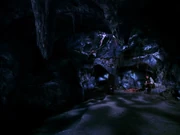
Caves on Risa
Later that year, arms dealer Farrakk visited Risa for a vacation instead of opening negotiations with the Verillians . ( DS9 : " Business as Usual ")
At some point in 2373, Raimus was on Risa and talked a Starfleet officer who was in command of the weather control system there into becoming an informant for the Orion Syndicate . ( DS9 : " Honor Among Thieves ")
In 2374 , Odo asked Bashir if an upcoming medical conference he was to attend would be on Risa. It was actually on another "sunny resort," Casperia Prime . ( DS9 : " Inquisition ")

A resort on Risa
When told by Jadzia Dax that she wanted a suffer-free honeymoon , Worf was worried she wanted to visit Risa again. She had actually chosen Casperia Prime. ( DS9 : " Change of Heart ")
When Grand Nagus Zek disappeared in mid- 2375 , Quark believed he was probably on Risa. In fact, he had traveled to the mirror universe . Zek himself knew that Quark would say he was on Risa. ( DS9 : " The Emperor's New Cloak ")
Doctor Bashir asked Sarina Douglas if she wanted to go to Risa. Their relationship ended before they could go. ( DS9 : " Chrysalis ")
Grand Nagus Zek and Ishka retired to Risa in 2375. ( DS9 : " The Dogs of War ")
Following the Battle of Cardassia and the prospect of a larger battle with the Dominion , Ezri Dax told Captain Sisko, " All things considered, I'd rather be on Risa. " Sisko noted, " That makes two of us. " ( DS9 : " What You Leave Behind ")
In 2380 , Quimp and his wife considered going to Risa for the weekend . ( LD : " Envoys ")
Mirror universe [ ]
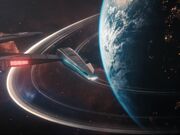
Mirror Risa
In the mirror universe , Risa was part of the Terran Empire as of 2255 . Unlike in the prime universe, mirror Risa had a ring system .
In an alternate timeline created by the Guardian of Forever in 3189 , the ISS Discovery captured Duggan , Gabriel Lorca 's lieutenant , in orbit of Risa in 2255. ( DIS : " Terra Firma, Part 2 ")
Further information [ ]
Spaceport authorities [ ].
- Risa Control
Points of interest [ ]

Risian birds in 2135
- Temtibi Lagoon
- Tropical Zone
Zoological [ ]
- Risian bird
- Risan sea turtle
Appendices [ ]
Appearances [ ].
- " Two Days and Two Nights "
- " The Seventh "
- " Terra Firma, Part 2 "
- " Captain's Holiday "
- " The Game "
- " Let He Who Is Without Sin... "
Background information [ ]
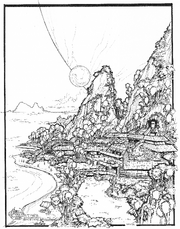
Concept art for Risa in DS9
There are two pronunciations for Risa. In the script for "The Mind's Eye", the pronunciation was "RYE-sa". [1] In the script for "Q-Less"", the pronunciation was "RYE-suh". [2] The latter pronunciation was used in the script for "Fallen Hero".
The concept of Risa was invented by Ira Steven Behr , who based the script for the episode "Captain's Holiday" on it. Gene Roddenberry approved of the idea of the "pleasure planet" but wanted to radically change Risa's culture to incorporate extremely graphic depictions of homosexual behavior, which Rick Berman advised Behr to ignore. ( William Shatner Presents: Chaos on the Bridge )
Years after working on Star Trek: The Next Generation , Patrick Stewart once claimed that Risa was the only planet from TNG that he could remember the name of. ( William Shatner Presents: Chaos on the Bridge )
For DS9 : " Let He Who Is Without Sin... ", sets representing guest chambers on Risa (such as Pascal Fullerton 's, as well as one used by Worf and Jadzia Dax ) were built on Paramount Stage 17 . ( citation needed • edit )
In ultimately omitted dialogue from the final draft script of ENT : " Desert Crossing ", Jonathan Archer and Charles Tucker III agreed that, when they arrived on Risa, the first thing they would do would be to "jump into the nearest swimming pool" they could find. In the same script, Risa was depicted as appearing in the episode's final shot, referred to in a scene description as "a beautiful, blue-green planet," despite the fact Risa does not appear in that episode's final version. Nonetheless, Risa was also referred to as a "blue-green planet" in the final draft script of ENT : " Two Days and Two Nights " and in incomplete visual effects footage from a deleted scene excluded from that episode (the latter of which can be seen in the special features of the ENT Season 1 DVD and Blu-ray ).
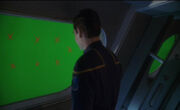
One of the shots in which Risa was intended to replace green screen
In the version of the ultimately deleted scene from the final draft script of "Two Days and Two Nights", a scene description stated, " Risa hangs enticingly outside the windows, " and another scene description mentioned "the promise of Risa shining through the windows." The filmed version of the scene demonstrates that, if the scene had been completed, the planet would have been inserted into the footage with replacement of green screen .
In another scene description from the final draft script of "Two Days and Two Nights", Risa was referred to as a "spectacular planet." The surface of the planet was also scripted to be extremely serene.
In a scene that was scripted for the end of ENT : " Home " (and included in the ENT Season 4 Blu-ray ) but never filmed, Risa was briefly mentioned, as one of several small rocks which Archer left at his father 's grave had been taken, by the captain, from Risa. In the same scene, Archer commented, as if to his deceased father, " That's a place I wish you could've seen. "
A reference to Risa was included in the first draft script of the aborted film Star Trek: The Beginning , set in 2159 . Risa was noted to be the location where Archer and Enterprise were during a series of Romulan attacks in the Sol system , which took place on 13 August 2159 and initiated the Earth-Romulan War .
At the conclusion of DIS Season 1 , After Trek host Matt Mira commented to Sonequa Martin-Green and Anthony Rapp that he thought the USS Discovery 's crew should set a course for Risa. Martin-Green agreed with this, since the Federation-Klingon War depicted in the series was now over, but Mira had to explain to her what Risa was before she understood. ( AT : " Will You Take My Hand? ")

The Risian emblem, tilted by 90°
A logo for Risa, depicting a sunset over an ocean, was created and shown in VOY : " Inside Man ", on Deanna Troi 's beach towel. A more colorful version was used in the reference book Star Trek: Star Charts (p. 53).
According to Star Trek: Star Charts (pp. 53, 56), the planet Risa (Epsilon Ceti B II) was class M and its government was the Risan Hedony. This planet was admitted into the United Federation of Planets in 2249 . The Risan capital was Nuvia. The population of Risa, which included Risans and individuals from many other species, in 2378 , was 2.81 billion, and, in an average year, up to 1.3 billion tourists visited the world. Points of interest included Temtibi Lagoon, Suraya Bay, and the Eluvian Mud Baths. The tropical climate was controlled by a weather control system. In the 24th century , Risa was a popular destination on the major space lanes.
Risa, the primary of Risa, was located in the Alpha Quadrant on a star chart visible in the Star Trek: Discovery episode " Magic to Make the Sanest Man Go Mad ".
The Star Trek Encyclopedia (4th ed., vol. 2, p. 225) described Risa as a tropical class M planet.
According to StarTrek.com , Risa was located in the same sector as Starbase 12 . [3]
Apocrypha [ ]
According to the RPG sourcebook Planets of the UFP , Risa was the third planet in the Tau Regulon system.
According to the RPG sourcebook Worlds , Risa was the third planet in the Granicus system.
The biography for Starfleet Lieutenant Hawk in the video game Star Trek: Starship Creator states that his parents Gwyneth and Ethan were residents of Risa.
The non- canon Star Trek: Destiny novel mini-series depicted Risa as one of the many worlds decimated during a Borg invasion of the Alpha Quadrant in 2381.
Before ENT : " Rajiin " established Nuvians to be a separate species, the reference to Nuvian masseuses on Risa in ENT : " Fallen Hero " was misinterpreted by the non-canon Star Trek: Star Charts , which lists the city of "Nuvia" as the capital of Risa.
External links [ ]
- Risa at Memory Beta , the wiki for licensed Star Trek works
- Epsilon Ceti at Wikipedia
- Re-Used Planets in DS9 at Ex Astris Scientia
- 1 Abdullah bin al-Hussein
- 3 John Paul Lona

COMMENTS
Riva was a famed Ramatisian mediator from the planet Ramatis III. He was a member of the ruling family on Ramatis, all of whom shared a genetic condition that rendered them deaf. ... (Star Trek: The Next Generation Companion (2nd ed., p. 73)) According to the episode's script, Riva was "around thirty years old" in 2365, placing his birth in or ...
Thus, Riva is turning his disadvantage of being unable to communicate into an advantage. The crew leaves Riva to await the tribe representatives. Production. Howie Seago, who is deaf, approached the show's producers with the idea of a deaf mediator. The initial idea came from his wife, who is a fan of Star Trek. The writers originally wanted ...
Loud as a Whisper: Directed by Larry Shaw. With Patrick Stewart, Jonathan Frakes, LeVar Burton, Michael Dorn. The crew ferries a deaf mediator to Solais V to negotiate an end to a civil war.
(Star Trek: The Next Generation Companion (2nd ed., p. 73)) The script of this episode stated that Riva was forced to learn sign language while mediating a conflict in the Plaeties system . The beings involved in the conflict were extremely paranoid and did not allow Riva's Chorus to accompany him, so in order to communicate on his own behalf ...
In the first draft, Riva learned to speak overnight after a mechanical translator he used to communicate with his chorus failed. Seago suggested the ending used in the finished episode the day prior to shooting. (Star Trek: The Next Generation Companion 2nd ed., p. 73)
Howie Seago (born 15 December 1953; age 70) is the actor, director, and producer who played Riva in the Star Trek: The Next Generation second season episode "Loud As A Whisper".Like his character, Seago is deaf. Born as Howard W. Seago in Tacoma, Washington he joined the National Theatre of the Deaf and acted in various plays around the world including Peter Sellar's "Ajax" and David Byrne's ...
In-depth critical reviews of Star Trek and some other sci-fi series. Includes all episodes of Star Trek: The Original Series, The Animated Series, The Next Generation, Deep Space Nine, Voyager, Enterprise, Discovery, Picard, Lower Decks, Prodigy, and Strange New Worlds. ... Riva turns out to be deaf, and he communicates through a "chorus" of ...
It contains some classic liberal Star Trek philosophy but it is presented in a fairly non cinematic way. To enjoy 'Loud As A Whisper' you need to be invested for the guest character of Riva who carries the main arc, along with Deanna Troi and have an appreciation for the use of communication to resolve conflict.
The Enterprise is dispatched to collect the famous mediator, Riva, so that they can transport him to mediate a dispute on Solais V. Before the away team beams down, Troi senses Worf's inner ...
Riva : I don't need your pity! Riva : [Riva and Picard are talking simultaneously] ... tired of all of you hearing people not understanding me! I'm not talking to you anyway. Captain Jean-Luc Picard : I'm sorry, I-I don't know what you are trying to tell me.
It is possible for Star Trek to do great issue-driven storylines. For example, Symbiosis was one of the better episodes of the first season. Classic episodes like The Outcast and Rejoined would tackle homosexuality in clever ways. However, these episodes also have a tendency to take themselves too seriously, to rather clumsily manhandle the issue at hand, and to forget that a television series ...
In Star Trek: The Next Generation's "Loud as a Whisper," Riva uses a version of sign language that is not standard American Sign Language (ASL), but rather an alien gestural language made up by Data actor Brent Spiner. After Riva's chorus is killed before the negotiation can even begin, Captain Picard orders Lt. Commander Data to learn Riva's language so that they can communicate.
Picard talking to Riva. Original air date: January 9, 1989. The Enterprise gets orders to transport a renowned mediator named Riva to Solais V to bring an end to a bitter war. Upon meeting him, the crew learns that he is deaf and speaks through three interpreters who communicate with him telepathically. Riva immediately finds himself taken with ...
Riva is played by Howie Seago, a well-known actor in the Deaf community and last seen Shake-ing his speare in a festival in Oregon as a member of the Oregon Shakespeare Festival Company. ... As a Star Trek episode, though, I thought it fell flat. Picard should have yelled at Pulaski for her eagerness to violate the Prime Directive for medical ...
Riva Riva Ramatis III Native Howie Seago The Next Generation Super Rare Crew Ramatis III Native Diplomat Linguist Telepath Cultural Figure Royalty Diplomacy Skill Science Skill Evasion New Life and New Civilizations Cultural Impact ... on the KellyPlanet Database for Star Trek Timelines Portrayed by Howie Seago and featured in The Next ...
Riva was a deaf ambassador for the United Federation of Planets native to the planet Ramatis III. In 2359, he and Sarek helped to broker a temporary peace between Cardassia and the Federation. (TLE novel: The Buried Age) He used a telepathic 'chorus' to talk to people. (TLE novel: The Art of the Impossible; TNG episode: "Loud as a Whisper") TLE novel: The Art of the Impossible TNG episode ...
He's still teaching them sign language. They're a pair of aggressive, yet slow to learn species. 1. 755K subscribers in the startrek community. A casual, constructive, and most importantly, welcoming place on the internet to talk about Star Trek.
Vacations in real life, and in Star Trek (in particular those that take place on Risa), always seem to go awry. Let's not forget Picard's ill-fated trip in Star Trek: The Next Generation's "Captain's Holiday."Like the crew of Archer's Enterprise, Picard was looking for a nice, relaxing break.Little does he know, he gets embroiled with Vash, the Ferengi, and the quest for the Tox Uthat.
If you think there should be something here, please reach out for support.
Career. He played Professor Seidel in the Angel episode "Supersymmetry".. On Star Trek: The Next Generation, Season 2 Episode 5, "Loud as a Whisper", aired January 9, 1989, he played one of three Interpreters known as Riva's Chorus.. Oglesby appeared in Independence Day (1996) as Mike Dodge. His most memorable moment is asking Randy Quaid if the aliens, who he claimed abducted him, did any ...
Riva's Chorus was a trio of telepaths who had lived with Riva since his childhood and who were extraordinarily attuned to his thoughts and emotions. Riva himself was deaf, a hereditary condition of the ruling dynasty of his planet, Ramatis III, and the chorus interpreted his thoughts and spoke on his behalf. The trio each spoke for different aspects of Riva. The "Scholar/Artist" spoke on ...
Star Trek: Discovery has always been about one thing: at the end of it all, the only thing that matters, the only thing that will bring light in dark times, and save the day, is a connection and ...
But, one wonderful 1968 episode from TOS Season 2 — "Return to Tomorrow" — featured ancient beings borrowing the bodies of Kirk, Spock, and Dr. Ann Mulhall in order to build more permanent ...
Wilson Cruz's Dr. Hugh Culber gets temporarily possessed by an 800-year-old Trill in Star Trek: Discovery season 5, episode 3, "Jinaal", and Cruz absolutely kills it with his performance. In its fifth and final season, Discovery sends Captain Michael Burnham (Sonequa Martin-Green) and the crew of the USS Discovery on an intergalactic treasure hunt to find the ancient and powerful treasure of ...
Michael Burnham's "Star Trek" journey was destined to be among the franchise's toughest and most complex.Some of us knew this from the moment Sonequa Martin-Green was cast to play her, especially ...
The fifth and final season of Star Trek: Discovery opens with " Red Directive, " where Captain Burnham and the crew of the U.S.S. Discovery are sent to retrieve a mysterious artifact hidden inside a 800-year-old Romulan vessel - but find that they're not the only ones on the hunt. Meanwhile, Saru is offered the position of a lifetime.
Rivan was the leader of the Edo who inhabited Rubicun III. She was among the group who welcomed the officers of the USS Enterprise-D in 2364. After the young Wesley Crusher was condemned to death for violating a law in one of the Edo punishment zones, Captain Picard brought her aboard on the Enterprise-D to attempt to reason with her. This way Rivan became the first Edo to see her home planet ...
Even the next most massive stellar black hole known in our galaxy, Cygnus X-1, only reaches 21 solar masses, making this new 33-solar-mass observation exceptional [1]. Remarkably, this black hole ...
The Risian emblem, tilted by 90° A logo for Risa, depicting a sunset over an ocean, was created and shown in VOY: "Inside Man", on Deanna Troi's beach towel. A more colorful version was used in the reference book Star Trek: Star Charts (p. 53).. According to Star Trek: Star Charts (pp. 53, 56), the planet Risa (Epsilon Ceti B II) was class M and its government was the Risan Hedony.